Metabolic Engineering of Escherichia coli Increas
多元模块工程在代谢工程中的应用与研究进展

2016年第35卷第11期 CHEMICAL INDUSTRY AND ENGINEERING PROGRESS·3619·化 工 进 展多元模块工程在代谢工程中的应用与研究进展刘丁玉1,2,3,孟娇1,2,3,王智文1,2,3,陈涛1,2,3,赵学明1,2,3(1天津大学化工学院,天津 300072;2教育部系统生物工程重点实验室,天津 300072;3天津化学化工协同创新中心,天津 300072)摘要:随着代谢工程理论体系的发展,代谢工程的研究方法目前已从对单一途径的调控转变为对整个代谢网络的全局调控。
同时,为了在工业微生物领域实现与化学工业生产规模相当的生物炼制过程,代谢工程需要一套通用的菌株优化策略。
其中关键问题之一,是解决代谢通量的不平衡。
本文介绍了基于传统的理性代谢工程与近年来兴起的组合工程中存在的问题,研究者提出了一种模块化的代谢网络优化策略——多元模块工程(multivariate modular metabolic engineering ,MMME )。
阐述了多元模块工程的原理和方法,列举了其常用的调控技术和手段,在此基础上综述了近年来模块化策略在代谢工程领域的应用进展,提出了该策略面临的主要问题并展望了其未来的发展方向。
关键词:多元模块工程;代谢工程;组合工程;合成生物学中图分类号:Q819 文献标志码:A 文章编号:1000–6613(2016)11–3619–08 DOI :10.16085/j.issn.1000-6613.2016.11.035Progress and application on multivariate modular metabolic engineeringin metabolic engineeringLIU Dingyu 1,2,3,MENG Jiao 1,2,3,WANG Zhiwen 1,2,3,CHEN Tao 1,2,3,ZHAO Xueming 1,2,3(1School of Chemical Engineering and Technology ,Tianjin University ,Tianjin 300072,China ;2Key Laboratory of Systems Bioengineering ,Ministry of Education ,Tianjin 300072,China ;3Collaborative Innovation Center of ChemicalScience and Engineering ,Tianjin 300072,China )Abstract :With the development of metabolic engineering ,the metabolic engineering research method of single pathway regulation has evolved into global metabolic network regulation. In order to realize the chemical industrial vision of ‘biorefineries’ in the field of industrial biotechnology ,metabolic engineering requires a systematic study with well-defined principles and tools. One of the key problems is balancing metabolic flux. Based on the traditional ,rational metabolic engineering and the rise of the problems existing in the combinatorial engineering in recent years ,the researchers proposed a modular metabolic network optimization strategy using multiple module projects. The modular strategies in progress of application in metabolic engineering during recent years are summarized. In addition ,the main problem and future direction of this strategy to optimize metabolic pathways are presented in light of the current knowledge of multiple module application.Key words :multivariate modular metabolic engineering ;metabolic engineering ;combinatorial engineering ;synthetic biology第一作者:刘丁玉(1987—),男,博士研究生,E-mail*****************.cn ;孟娇(1990—),女,硕士研究生,E-mail ****************.cn 。
反相高效液相色谱法测定苹果酸发酵液中的有机酸
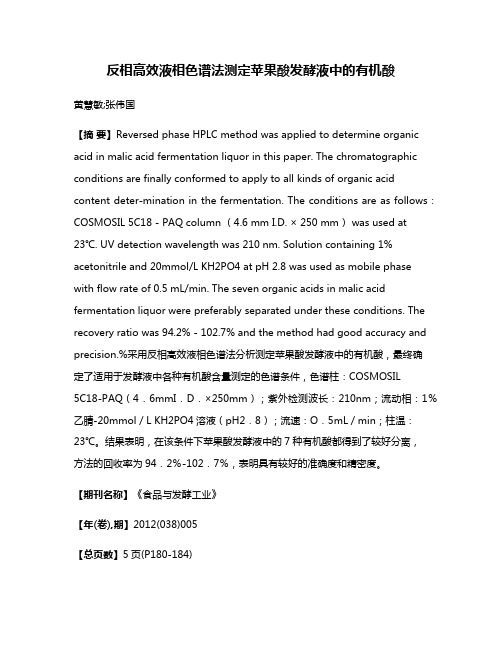
反相高效液相色谱法测定苹果酸发酵液中的有机酸黄慧敏;张伟国【摘要】Reversed phase HPLC method was applied to determine organic acid in malic acid fermentation liquor in this paper. The chromatographic conditions are finally conformed to apply to all kinds of organic acid content deter-mination in the fermentation. The conditions are as follows:COSMOSIL 5C18 - PAQ column (4.6 mm I.D. × 250 mm) was used at 23℃. UV detection wavelength was 210 nm. Solution containing 1% acetonitrile and 20mmol/L KH2PO4 at pH 2.8 was used as mobile phase with flow rate of 0.5 mL/min. The seven organic acids in malic acid fermentation liquor were preferably separated under these conditions. The recovery ratio was 94.2% - 102.7% and the method had good accuracy and precision.%采用反相高效液相色谱法分析测定苹果酸发酵液中的有机酸,最终确定了适用于发酵液中各种有机酸含量测定的色谱条件,色谱柱:COSMOSIL5C18-PAQ(4.6mmI.D.×250mm);紫外检测波长:210nm;流动相:1%乙腈-20mmol/L KH2PO4溶液(pH2.8);流速:O.5mL/min;柱温:23℃。
大肠杆菌代谢生产精氨酸
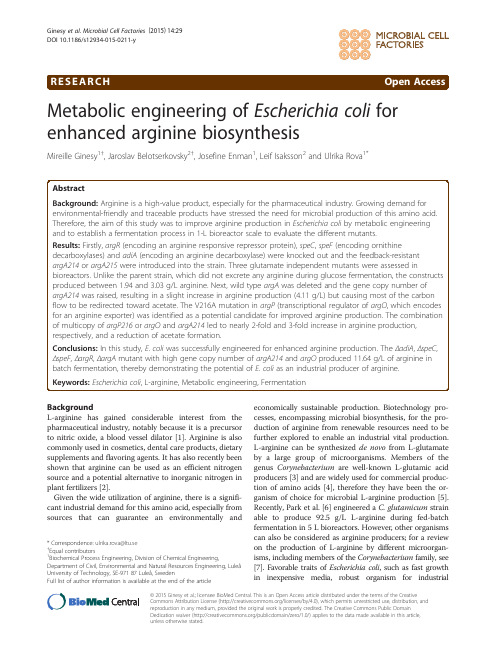
Metabolic engineering of Escherichia coli for enhanced arginine biosynthesisMireille Ginesy 1†,Jaroslav Belotserkovsky 2†,Josefine Enman 1,Leif Isaksson 2and Ulrika Rova 1*BackgroundL-arginine has gained considerable interest from the pharmaceutical industry,notably because it is a precursor to nitric oxide,a blood vessel dilator [1].Arginine is also commonly used in cosmetics,dental care products,dietary supplements and flavoring agents.It has also recently been shown that arginine can be used as an efficient nitrogen source and a potential alternative to inorganic nitrogen in plant fertilizers [2].Given the wide utilization of arginine,there is a signifi-cant industrial demand for this amino acid,especially from sources that can guarantee an environmentally andeconomically sustainable production.Biotechnology pro-cesses,encompassing microbial biosynthesis,for the pro-duction of arginine from renewable resources need to be further explored to enable an industrial vital production.L-arginine can be synthesized de novo from L-glutamate by a large group of microorganisms.Members of the genus Corynebacterium are well-known L-glutamic acid producers [3]and are widely used for commercial produc-tion of amino acids [4],therefore they have been the or-ganism of choice for microbial L-arginine production [5].Recently,Park et al.[6]engineered a C.glutamicum strain able to produce 92.5g/L L-arginine during fed-batch fermentation in 5L bioreactors.However,other organisms can also be considered as arginine producers;for a review on the production of L-arginine by different microorgan-isms,including members of the Corynebacterium family,see [7].Favorable traits of Escherichia coli ,such as fast growth in inexpensive media,robust organism for industrial*Correspondence:ulrika.rova@ltu.se †Equal contributors 1Biochemical Process Engineering,Division of Chemical Engineering,Department of Civil,Environmental and Natural Resources Engineering,LuleåUniversity of Technology,SE-97187Luleå,SwedenFull list of author information is available at the end of thearticle©2015Ginesy et al.;licensee BioMed Central.This is an Open Access article distributed under the terms of the Creative Commons Attribution License (/licenses/by/4.0),which permits unrestricted use,distribution,and reproduction in any medium,provided the original work is properly credited.The Creative Commons Public Domain Dedication waiver (/publicdomain/zero/1.0/)applies to the data made available in this article,unless otherwise stated.Ginesy et al.Microbial Cell Factories (2015) 14:29 DOI 10.1186/s12934-015-0211-yprocesses,and its well characterized metabolism and avail-able molecular tools for genetic engineering,render it an or-ganism of interest for the production of arginine.A number of patents regarding arginine production by E.coli strains exist(e.g.[8-10]).The inventors claim to have obtained up to19.3g/L in batch-fermentations with an acetate utilizing mutant derived from an arginine producing E.coli strain[8] and11.6g/L in2mL test tubes by attenuating the expres-sion of genes encoding the lysine/arginine/ornithine ABC transporter[9].However,the literature concerning E.coli and arginine biosynthesis has mainly been focused on the genetics and regulation systems rather than the production.To the best of our knowledge,no study has been published on the fermentative production of arginine by E.coli.In E.coli,arginine biosynthesis follows a linear pathway starting from the precursors glutamate and acetyl-CoA (Figure1).The first enzyme in the biosynthetic pathway,N-acetylglutamate synthase(NAGS)encoded by the argA gene,is inhibited by arginine through feedback inhibition [11].In addition,the arginine responsive repressor protein ArgR,encoded by the argR gene,negatively regulates tran-scription of arginine biosynthesis genes[12].E.coli also possesses machineries for the export of some amino acids,including arginine.The arginine exportpumpArgO,encoded by the argO gene,is transcriptionally regu-lated by ArgP[13-15].The latter is responsive to intracellu-lar arginine levels and activates the transcription of argOaccordingly[15-17].In addition,E.coli has degradativepathways for both L-arginine and its precursor L-ornithine.Two ornithine decarboxylases(encoded by the speC andspeF genes)are responsible for the conversion of ornithineto putrescine[18,19],whereas arginine is first degraded intoagmatine by an arginine decarboxylase(encoded by adiA),which is subsequently converted to putrescine and urea[18].In summary,the biosynthesis pathway of arginine isconstrained by several layers of metabolic and transcrip-tional regulations resulting in a complex network to engin-eer for arginine overproduction.Arginine overproducing E.coli strains have been classically obtained by selection ofcanavanine-resistant mutants[20].Canavanine,an arginineanalogue,inhibits growth by competing for arginine in pro-tein synthesis[21].The rationale for using this selectionsystem is that mutants resistant to canavanine are likely tobe derepressed for arginine synthesis,as over-production ofarginine will release the inhibition caused by canavanine.When characterized,these mutants have subsequently beenfound to carry mutations in argA,argR and in some in-stances argP[12,22,23].Not surprisingly,mutations in argAcommonly resulted in an ArgA feedback resistant to argin-ine,which led some workers to derive further mutants bydirected selection[24].Similarly,mutations in argP resultedin ArgP acting in a constitutive manner,independent of thepresence of arginine[14,17].In this study we used both rational design based onknown regulatory and metabolic information and selectionprocedures aiming for E.coli strains with enhanced pro-duction of arginine.Experimental validation of the engi-neered strains was carried out in1-L fermenters undercontrolled conditions.We examined first the impact of de-leting the speC,speF,adiA and argR genes and introducinga feedback-resistant argA.Then,the wild type argA wasknocked-out and the feedback-resistant variant overex-pressed.Finally,arginine production was significantly in-creased by overexpression of either argP or argO. Results&discussionEffect of introduction of feedback resistant variants of argA and selection of glutamate producing strainsIn the first rate-limiting step of the arginine synthesis,NAGS,encoded by argA,catalyzes the acetylation of glu-tamate.To block the feedback inhibition of NAGS theplasmids pKH15and pKH19,derived from the ASKA-plasmid pCA24N,were transferred into C600+Δ4(see Table1)to over-express the feedback resistant variants ofargA(H15Y for argA214and Y19C for argA215)underthe control of an IPTG-inducible promoter[25](Table1).The strain C600+Δ4carrying either plasmid pKH15or pKH19could not be grown on M9minimal media containing IPTG without exogenous glutamate supple-mentation and only weak growth was observed on the same medium when both glutamate and IPTG were ab-sent.This suggested that over-expression of the feedback resistant argA in this strain resulted in glutamate starva-tion.To overcome this limitation,spontaneous mutants able to grow in the absence of glutamate were selected by plating washed and diluted cell cultures on M9medium supplemented with IPTG without glutamate.Twelve col-onies were picked at random and screened for arginine production based on the bioassay method.The three clones with the highest arginine production were chosen for subsequent work(SJB001,003and004).Although these three strains were constructed in the same way,fermentations revealed very different growth behavior and arginine production abilities(Table2).Indeed,SJB003 produced more arginine,with a productivity of0.14g/L/h and a final arginine concentration(3.03g/L)significantly higher than that of the other similar mutants.The higher ar-ginine producing capability of SJB003compared to that of SJB001and004indicates that this strain had acquired benefi-cial mutations during growth under glutamate limitation. SJB003was therefore chosen as a chassis for further genetic manipulation,although its beneficial mutations were not characterized.Control fermentations with the parent strain C600+ were also performed.This strain did not yield any argin-ine(data not shown),which confirmed that the arginine productions displayed by the other strains are the result of their genetic modifications.Effect of overexpression of a feedback resistant argA on arginine productionTo avoid the use of IPTG in an industrial process,it is of interest to place the feedback resistant argA gene under a constitutive promoter.First the SJB003was cured of the pKH19plasmid,harboring argA215,by re-peated streaking on Luria Agar(LA)medium without antibiotic,giving rise to SJB003A.The argA214allele was chosen as the argA variant to be introduced in the strain since we found this allele to be slightly better for arginine productivity in preliminary shake flask experi-ments(data not shown).To avoid potential recombin-ation with the new argA214plasmid,the chromosomal copy of the wild type argA gene was deleted in the SJB003A strain,resulting in SJB005.The feedback resistant argA214was cloned into a high copy number plasmid pJB044downstream of the infA gene encoding the translation initiation factor IF1.pJB044carries a tetracycline resistance gene that can be removed by hom-ologous recombination due to the presence of direct repeats flanking the gene,as previously described[27].The argA214gene was placed downstream of the ribosome binding site(RBS)(AGGAGG)either with or without astrong constitutive rRNA promoter(rrsBp1)upstream (Table1).The argA start codon GUG was changed by site-directed mutagenesis to the more efficient AUG codon in both constructs,termed pJB044argA15and pJB044p1argA15.Strain SJB005was the host of the pJB044derived plasmids,resulting in the two IPTG-independent strains SJB0015and SJB025that differ only by the absence or presence of a strong rRNA promoter upstream of the argA214gene respectively.When cultivated in bioreactors,SJB015displayed a slightly improved arginine production compared to the previous constructs(T able2).In particular,Y P/x was relatively high (0.50g arg/g dcw).However,cell growth was seriously ham-pered for this strain and SJB015had the lowestμand Y X/S and the final cell density was lower than that of the other strains(data not shown).Consequently the volumetric prod-uctivity of SJB015was relatively low(0.08g/L/h).In addition,SJB015produced high levels of acetate.When a DCW of about7g/L was reached(Figure2d),cell growth stopped,arginine production drastically decreased and the remaining sugar(approximately30%of the initial glucose) was mainly used for acetate formation(up to28g/L).SJB025exhibited slow growth on both rich(LA)and minimal medium(M9)with the appearance of some large colonies(data not shown).This suggested that the strong promoter driven argA214was toxic for the strain, with large colonies representing revertants.50of these colonies were screened for fast growing mutants withTable1Plasmids and strains used in this studyPlasmid/Strain Relevant characteristics/genotype Source/ReferencePlasmidspKH15pCA24N(clone JW2786),argA214ASKA-collection[26],this work pKH19pCA24N(clone JW2786),argA215ASKA-collection[26],this work pTrc99a Amp-R,lacIq Lab stockpTrcArgP216pTrc99a with a mutant argP216allele This workpJB044pBR322derived,infA,rop-Lab stock[27]pJB044argA15pJB044with argA214downstream of infA This workpJB044p1argA15Same as pJB044argA15but with rrsBp1This workpArgObla Arginine bio-sensor plasmid with bla(Amp-R)under transcriptional control of argOp This workpArgObla10C Arginine bio-sensor plasmid with bla(Amp-R)under transcriptional controlof argOp with mutation in RBSThis workpTrcArgP216pTrc99a with argP216cloned under transcriptional control of trc promoter This workpJB044argAO pJB044argA15with argO cloned downstream of argA214This workpJB044argAP pJB044argA15with argp216cloned downstream of argA214This workStrainsE.coli K-12C600thr-,1leuB6,thi-1,lacY1,glnV44,supE44,rfbD1,mcrA1Lab stock[28]MG1655ilvG-,rfb-50,rph-1Lab stockC600+Same as C600but thr+,leu+This workC600+Δ4Same as C600+butΔadiA,ΔspeC,ΔspeF,ΔargR This workpTrcArgP216/C600+Δ4C600+Δ4with a mutant argP216allele This workJW3932Auxotrophic for arginineΔargH[29]SJB001Glutamate independent mutant of C600+Δ4with pKH15(clone2)This workSJB003Glutamate independent mutant of C600+Δ4with pKH19(clone2)This workSJB004Glutamate independent mutant of C600+Δ4with pKH19(clone4)This workSJB003A SJB003but no plasmid This workSJB005SJB003A butΔargA This workSJB015SJB005with pJB044argA15This workSJB025SJB005with pJB044p1argA15This workSJB006Arginine producing mutant of C600+Δ4from biosensor selection,argP216This workSJB007Derivative of SJB006from second round biosensor selection This workSJB009SJB005with pJB044argAO This workSJB010SJB005with pJB044argAP This workenhanced ability to produce arginine.However,none had retained this capacity(ascertained by the bioassay method)and consequently,neither these clones nor the parental SJB025were used for further work.For this strain it is likely that the rate of arginine forma-tion exceeds the capacity of the arginine export system due to the overexpression of argA214in combination with the presence of a strong promoter upstream of argA214.The resulting accumulation of arginine inside the cellmight have a variety of negative effects on cellular pro-cesses,which could explain why cell growth was seriouslyhampered in SJB025and the ability for enhanced arginineproduction easily lost.This is consistent with previous re-ports,where mutants of C.glutamicum with deletion oflysE,encoding an exporter similar to ArgO[30,31],weregrowth inhibited in the presence of intracellular arginine[30-32].Growth arrest due to intracellular arginine in ΔargO andΔargP mutants of E.coli has also been re-ported[14].The increased nitrogen flow towards arginineproduction might also hinder the biosynthesis of othermetabolites required for cell growth.Identification of novel mutations for enhanced arginine production using a biosensorTo complement the above described rational strain im-provement strategies,a selection procedure wasemployed to select novel or previously unidentified mu-tants with increased arginine production.C600+Δ4car-rying the biosensor plasmid pArgObla10C was used fordirect selection and screening of arginine accumulatingmutants on M9plates supplemented with2,3and4mg/mL Amp.Only mutants with increased expressionof the bla gene,most likely through increased transcrip-tion of the argOp promoter,can grow on media withAmp concentration higher than0.6mg/mL.High Amp resistant mutants were randomly chosenfrom each Amp concentration and assayed for arginineproduction using the bioassay method.The isolated mu-tant showing the highest production was cured of theplasmid by repeated streaking on M9plates without anti-biotic(resulting in SJB006).After the biosensor plasmidremoval an improved arginine production was retained,indicating that the acquired increased arginine accumula-tion was due to chromosomal mutations.Chromosomalsequencing of argA and argP genes in this clone revealedwild type argA and a T647C mutation in argP resulting ina valine to alanine mutation in position216(V216A).To assess the effect of the V216A mutation on arginineproduction the mutant allele argP216was cloned into ahigh copy number plasmid downstream of an IPTG indu-cible promoter(pTrc99a)to give pTrcArgP216.Evenwithout IPTG induction,the arginine accumulation of thestrain pTrcArgP216/C600+Δ4was equivalent to SJB006, as based on the bioassay method(data not shown).We thus concluded that the increase in arginine accumulation observed in SJB006was at least partly due to the presence of the argP216allele.Selection of mutants with increased arginine accumula-tion was extended by transforming SJB006with pArgO-bla10C anew,and screening on LA plates supplementedwith6,8and10mg/mL of Amp.Several colonies wereassayed for arginine production;the best clone was cured of the biosensor plasmid and used for further work (SJB007).Sequencing of argA and argP showed that SJB007 also carried wild-type argA and no other mutation on the argP gene,other than the V216A mutation present in the parent strain SJB006.Even with only the wild type argA,SJB006produced simi-lar amounts of arginine as SJB001and SJB004during fer-mentation(Table2).Further,the productivity of SJB006 (0.11g/L/h)was even slightly higher due to a faster growth. SJB007,which results from a second level biosensor selec-tion,displayed increased arginine production compare to its parent SJB006.This demonstrates the potential effects of the mutation V216A carried by these two strains on the argP gene,but also that there might be some additional unknown mutation in SJB007promoting arginine production.Effect of co-overexpression of a feedback resistant argA and argP or argO on arginine productionThe mutant allele argP216resulted in increased accu-mulation of arginine.Amongst other physiological func-tions in the cells,ArgP also controls the transcription of argO.It was therefore of interest to combine overexpres-sion of each of these two genes with the known feedback resistant argA214allele.The plasmid pJB044argAP was constructed such that the argP216allele was placed downstream of argA214, under the control of the RBS sequence AGGAGG.The plasmid pJB044argAO was constructed by placing an argO ORF with the RBS sequence AGGAGG,downstream of argA214.In addition the inefficient start codon GUG was changed for the canonical AUG.The plasmids pJB044ar-gAO and pJB044argAP were transferred to SJB005,to yield SBJ009and SJB010respectively.Slow growth was also observed in the strains having a gene involved in arginine transport overexpressed in combination with the argA214allele(Figure2d,g and h).In particular,SJB009had almost the sameμand Y X/S as SJB015and also produced significant amounts of acetate.Nevertheless,cells grew to a somewhat higher density and arginine was steadily formed throughout the whole fermentation.Furthermore,SJB009had the highest arginine production per amount of cells(1.18g arg/g DCW),2to13-fold that of the other strains.Consequently this strain yielded the highest final arginine titer(11.64g/L) at a fair production rate(0.24g/L/h).Also,a low growth associated with a high Y P/X means that a large part of the glucose is used for arginine formation.SJB009therefore showed the highest Y P/S(0.17g arg/g glc)of all strains eval-uated.ArgO is directly responsible for the transport of ar-ginine outside the cytoplasm and the high Y P/S might be the result of an immediate excretion,enhanced by ArgO,of the large amount of arginine produced,due to argA214. Interestingly,despite overexpression of the argP gene,re-sponsible for argO transcription,SJB010had significantlylower product yields than SJB009,yet higher than the other mutants.However,the cells of this strain grew twice as fast as cells of SJB009and therefore SJB010had the highest productivity of all strains(0.29g/L/h).Unlike SJB015and SJB009,SJB010did not form high levels of acetate but pro-duced both acetate and succinate(4–5g/L).SJB009and SJB010are similar to SJB015except that one of their genes responsible of arginine export has been altered(argO and argP,respectively).This resulted in an important increase in the final arginine concentration (+183%and+93%),productivity(+200%and+262%)and product yield Y P/S(+143%and+57%)for SJB009and SJB010,respectively,compared to SJB015.This positive ef-fect of argO and argP overexpression has previously been observed,showing that E.coli strains carrying multicopy yggA+(argO)and argP d(S94L mutation)had a greatly in-creased arginine production as determined from cross-feeding ability on agar plate[14].Export has been identified as the rate-limiting step for the production of different amino acids when using C.glutamicum[33-35].Similarly, it seems that the arginine export system plays a major role for the arginine production by E.coli.Formation of acetate during arginine fermentationAll mutants produced acetate as the main by-product. Acetate is formed during the5th step of L-arginine bio-synthesis from L-glutamate(Figure1).However,for most strains the ratio of ac:arg produced was higher than1:1(Table2),which means that acetate was also formed via another pathway.The accumulation of acetate by E.coli,even in aerobic environment,when growing under conditions of high glucose consumption is known as overflow metabolism. It occurs when the rate of glucose consumption is greater than the capacity of the cell to reoxidize the re-duced equivalents,i.e.NAD(P)H,generated by glycolysis. Instead of entering the tricarboxylic acid(TCA)cycle, the carbon flux from acetyl-CoA is diverted to acetate, likely to prevent any further NAD(P)H accumulation as only ATP is formed during acetate formation while the TCA cycle generates several reducing equivalents [36,37].As fermentations were run in batch mode with high initial glucose concentration(70g/L)overflow metabolism is to be expected.The acetate production depends on the specific glucose uptake rate,with acetate formation occurring only after a certain threshold[36].SJB001;3;4;6and7indeed produced large amounts of acetate compared to arginine, which allowed them to have a high glucose uptake(0.44to 0.54mol glc/mol dcw/h)and a fast growth(μ>0.13h−1). SJB009and SJB010however had a considerably lower ac/ arg ratio,i.e.3.72and1.17mol/mol,respectively,compared to at least5.9mol/mol for the other strains.The glucose up-take was also reduced(0.33and0.36mol glc/mol dcw/h)as well as the growth(μ<0.09h−1).It is possible that the redir-ection of carbon and nitrogen toward arginine results in a shortage of other essential amino acids,thereby limiting the growth and the need for fast glucose assimilation.This could also be because the carbon flow from acetyl-CoA is forced toward arginine biosynthesis by the overexpressed argA214, thereby limiting the formation of acetate from acetyl-CoA. However SJB015had the highest ac/arg ratio (11.37mol/mol)despite having a low specific glucose uptake(0.36mol glc/mol dcw/h).This strain produced 15.85g/L of acetate,which is comparable to the14.56g/L produced by SJB009.It is therefore likely thata large part of the acetate produced by SJB015comes from the increased carbon flux through the arginine pathway,but that mainly acetate was excreted while ar-ginine accumulated inside the cell due to the export limitation.ConclusionWe reported the development E.coli strains overproducing arginine,by targeting genes regulating repression of arginine biosynthesis and competing degradation pathways in addition to amplification of genes for N-acetylglutamate for-mation and arginine export.The two final strains obtained (SJB009and SJB010)had the highest arginine yield(1.18 and0.44g arg/g glc,respectively)and productivity(0.24and 0.29g arg/L/h,respectively)and will be used for further gen-etic improvement and/or process optimization.The fermen-tation process developed for the comparison of the different constructs needs to be further optimized regarding fermen-tation medium,process conditions and process control. Materials and methodsStrain constructionBacterial strains and plasmidsTable1lists the plasmids and bacterial strains used in this study.In addition,the E.coli strain DH5αwas used as a primary host for all cloning work.Cultivation mediaStrains were grown for24–48h in15mL tubes at37°C and 220rpm on Luria Bertani(LB)or in M9minimal media supplemented with thiamine5μg/mL and with the addition of1.5%agar when solid media was used.When necessary, glutamate was supplemented at0.8mM.Unless otherwise indicated,antibiotics were used at the following concentra-tions:tetracycline20μg/mL;chloramphenicol50μg/mL; kanamycin50μg/mL;ampicillin(Amp)200μg/mL.For in-duction experiments,IPTG was used at a final concentra-tion of0.1mM.DNA manipulationCloning of genes and regulatory elements was achieved ei-ther through standard restriction enzyme based cloningmethods,or with the use of the sequence-and ligation-in-dependent cloning method[24].Site directed mutagenesis was used in order to introduce single nucleotide alterations into plasmids[38].All gene deletions were done according to the in-frame gene excision method described by Link et al.[39].Deletions were verified by PCR and DNA sequencing.Construction of a base strain for arginine production(C600+Δ4)A base strain with deletions of key genes involved in the arginine and ornithine degradation pathways and the ar-ginine repression system was first constructed.The threonine and leucine auxotrophic E.coli strain K-12 C600[18]was used as a starting strain.C600was made autotrophic by moving wild type alleles from MG1655 donor strain via P1transduction and subsequent selec-tion on M9plates without any amino acids.The result-ant strain was termed C600+.One target for increased arginine production was inactivation of the arginine re-pressor argR and genes in the arginine and ornithine degradation pathways.The genes argR,adiA,speC and speF were subsequently deleted in order to obtain the strain termed C600+Δ4.Biosensor plasmid constructionTo select for arginine producing mutants with previously unidentified mutations,a biosensor plasmid termed pArgO-bla,was engineered based on one previously described[40]. The arginine sensitive promoter argOp was used to control the transcription of the ampicillin resistance gene bla.In addition,the T1T2terminator was placed upstream to pre-vent any transcription from upstream promoters.Plasmid sensitivity to arginine was decreased by mutating the core RBS AAGGA upstream of the bla gene to ACGGA to re-duce the efficiency of the translation initiation.The Amp minimum inhibitory concentration was considerably re-duced for C600+Δ4carrying this new biosensor variant pAr-gObla10C,compared to pArgObla(from>5mg/mL to 0.6mg/mL).Bioassay for screening of arginine producing mutants Spent M9growth media from cultures of candidate argin-ine producers were separated from the cell biomass by centrifugation at10500×g for5minutes.The supernatant was then sterilized with a0.2μm filter and diluted into the assay medium,i.e.M9supplemented with Kan.The strain JW3932,which was obtained from the Keio collection [29],is auxotrophic for arginine(ΔargH).This strain was inoculated into the assay medium and its growth(mea-sured as OD590)was used to determine the arginine con-centration,based on a reference curve constructed from known concentrations of arginine.FermentationsSeed cultures preparationCultures of the strains constructed as described above were stored in LB at−80°C as15%glycerol stocks.The medium used for cultivation of the strains consisted of (per liter):70g glucose,15g corn steep liquor,15g(NH4) 2SO4,1g KH2PO4,0.5g MgSO4·7H2O,20mg FeSO4·7 H2O,12mg MnSO4·H2O,0.5mg thiamine·HCl and ap-propriate concentrations of antibiotics.1mL of the stock culture was inoculated to a500-mL shake flask containing 100mL of sterile medium and4g CaCO3to maintain a pH of about7.The seed culture was incubated at32°C in an orbital shaker at200rpm until an optical density at 562nm(OD562)between1.6and2.5was reached.FermentationsBatch fermentations were conducted in1L bioreactors(Bio-bundle1L,Applikon Biotechnology,the Netherlands).The medium used was the same as described above,supple-mented with0.4g/L of antifoam.100mL of seed culture were added in a sterile bioreactor containing600mL of medium.Prior to inoculation,pH was adjusted to7and thereafter maintained at that pH by automatic addition of NH3solution(14-15%v/v).Fermentations were performed at32°C and initial stirring was set at500rpm.The dissolved oxygen concentration(DO)was controlled with pulses of air (at10vvm)and to maintain a DO level above30%the stir-ring was gradually increased from500rpm to1000rpm.All fermentations were carried out in duplicates.Samples were regularly taken throughout the fermen-tations for analysis of optical density,glucose,organic acids and arginine concentrations.Cell growth measurementCell growth was estimated by measuring the OD562of ap-propriately diluted samples.Dry cell weight(DCW,in g/L) was determined from the optical density using a linear relationship between OD562and DCW established in our laboratory under similar conditions:DCW=0.4507×OD562+0.6095.Glucose and organic acids analysisThe samples were centrifuged for10min at10621×g and 4°C.The supernatant was then diluted five times with water and filtered through a0.2μm syringe filter.Quantifi-cation of glucose and organic acids was performed by HPLC using a guard column(Micro-Guard IG Cation H Cartridge,BioRad),a cation exchange column(Aminex HPX87-H,BioRad)and a Series200refractive index de-tector(PerkinElmer).The column was kept at65°C and 0.005M H2SO4at a flow rate of0.6mL/min was used as mobile phase.。
左旋多巴的合成研究新进展

左旋多巴的合成研究新进展陈五九;曹鹏;宋国田;彭彦峰;吴凤礼;王钦宏【摘要】左旋多巴(L-DOPA)是治疗帕金森病的最有效药物,在各国的临床中应用广泛.左旋多巴的制备方法包括化学合成、植物提取、酶催化以及微生物合成.化学合成法存在低转化率和环境污染问题.植物提取法不仅产量低,还受到资源限制.酶催化法使用包括酪氨酸酚解酶、酪氨酸酶及羟基苯乙酸 3-羟化酶等催化苯类前体合成左旋多巴.随着合成生物学的发展,构建代谢工程微生物、发酵法生产左旋多巴是一种高效、环境友好的新方法,具有良好的应用前景.%L-DOPA is the most effective drug for Parkinson's disease and has been widely used in clinical treatment of various countries.The preparation methods of L-DOPA include chemical synthesis,plant extraction,enzyme catalysis,and microbial synthesis.However,Chemical syn-thesis has low conversion rate and environmental pollution problems.The plant extraction method not only has a low yield but is also subject to resource constraints.Enzymatic to L-DO-PA has been catalyzed by tyrosine phenol lyase,tyrosinase and p-hydroxyphenylacetate 3-hydroxylase.The enzyme-catalyzed method uses catalyzed benzene precursors such as tyrosine phenolase,tyrosinase and p-hydroxyphenylacetate 3-hydroxylase to synthesize L-DOPA.With the development of synthetic biology,fermentation of L-DOPA by constructing metabolically engineered microorganisms would be a new high efficient and environment-friendly method,which demonstrates a promising process.【期刊名称】《广西科学》【年(卷),期】2018(025)003【总页数】5页(P274-278)【关键词】左旋多巴;不对称合成;植物提取;酶催化;代谢工程【作者】陈五九;曹鹏;宋国田;彭彦峰;吴凤礼;王钦宏【作者单位】中国科学院天津工业生物技术研究所,中国科学院系统微生物工程重点实验室,天津 300308;中国科学院天津工业生物技术研究所,中国科学院系统微生物工程重点实验室,天津 300308;中国科学院天津工业生物技术研究所,中国科学院系统微生物工程重点实验室,天津 300308;中国科学院天津工业生物技术研究所,中国科学院系统微生物工程重点实验室,天津 300308;中国科学院天津工业生物技术研究所,中国科学院系统微生物工程重点实验室,天津 300308;中国科学院天津工业生物技术研究所,中国科学院系统微生物工程重点实验室,天津 300308【正文语种】中文【中图分类】Q939.97;TQ920 引言左旋多巴(L-DOPA)化学名为β-3,4-二羟苯基-α-丙氨酸(3,4-2dihydroxylphenylalanine)(图1a),为白色结晶性粉末,无臭无味,不溶于乙醇、氯仿和丙酮,易溶于稀酸。
微生物生产L_苏氨酸的代谢工程研究进展_董迅衍
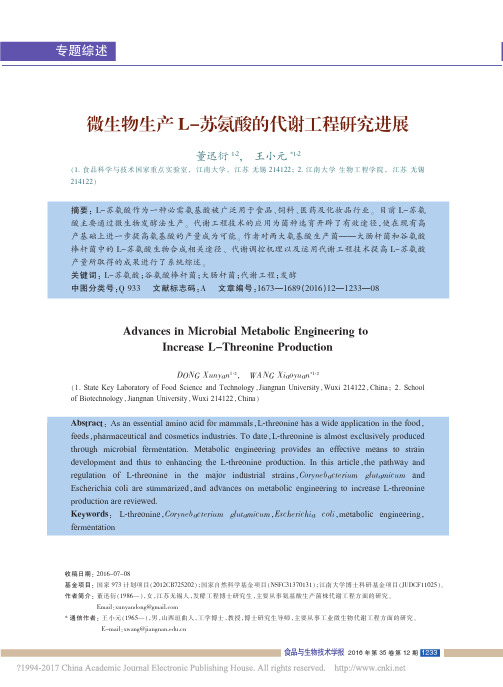
Advances in Microbial Metabolic Engineering toIncrease L-Threonine ProductionDONG Xunyan 1,2,WANG Xiaoyuan *1,2(1.State Key Laboratory of Food Science and Technology ,Jiangnan University ,Wuxi 214122,China ;2.Schoolof Biotechnology ,Jiangnan University ,Wuxi 214122,China )Abstract :As an essential amino acid for mammals ,L-threonine has a wide application in the food ,feeds ,pharmaceutical and cosmetics industries.To date ,L-threonine is almost exclusively produced through microbial fermentation.Metabolic engineering provides an effective means to strain development and thus to enhancing the L-threonine production.In this article ,the pathway and regulation of L-threonine in the major industrial strains ,Corynebacterium glutamicum and Escherichia coli are summarized ,and advances on metabolic engineering to increase L-threonine production are reviewed.Keywords :L-threonine ,Corynebacterium glutamicum ,Escherichia coli ,metabolic engineering ,fermentation摘要:L-苏氨酸作为一种必需氨基酸被广泛用于食品、饲料、医药及化妆品行业。
大肠杆菌转运蛋白SstT和RhtC的改造对L-苏氨酸产量的影响
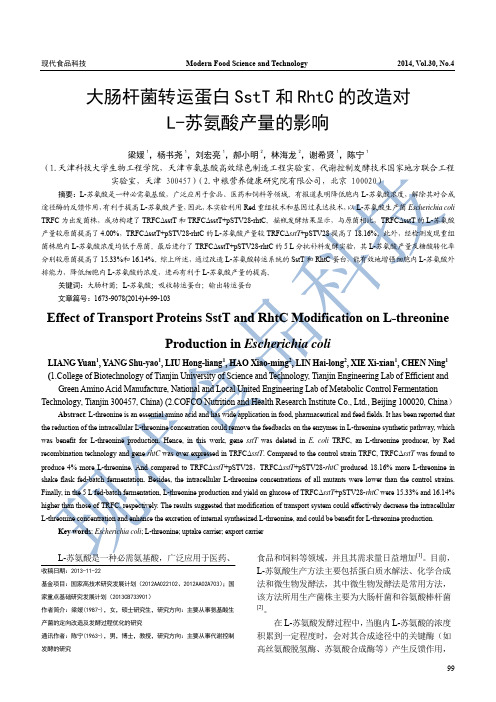
大肠杆菌转运蛋白SstT 和RhtC 的改造对L-苏氨酸产量的影响梁媛1,杨书尧1,刘宏亮1,郝小明2,林海龙2,谢希贤1,陈宁1(1.天津科技大学生物工程学院,天津市氨基酸高效绿色制造工程实验室,代谢控制发酵技术国家地方联合工程实验室,天津 300457)(2.中粮营养健康研究院有限公司,北京 100020)摘要:L-苏氨酸是一种必需氨基酸,广泛应用于食品、医药和饲料等领域。
有报道表明降低胞内L-苏氨酸浓度,解除其对合成途径酶的反馈作用,有利于提高L-苏氨酸产量,因此,本实验利用Red 重组技术和基因过表达技术,以L-苏氨酸生产菌Escherichia coli TRFC 为出发菌株,成功构建了TRFC ΔsstT 和TRFC ΔsstT+pSTV28-rhtC 。
摇瓶发酵结果显示,与原菌相比,TRFC ΔsstT 的L-苏氨酸产量较原菌提高了4.00%,TRFC ΔsstT+pSTV28-rhtC 的L-苏氨酸产量较TRFC ΔsstT +pSTV28提高了18.16%。
此外,经检测发现重组菌株胞内L-苏氨酸浓度均低于原菌。
最后进行了TRFC ΔsstT+pSTV28-rhtC 的5 L 分批补料发酵实验,其L-苏氨酸产量及糖酸转化率分别较原菌提高了15.33%和16.14%。
综上所述,通过改造L-苏氨酸转运系统的SstT 和RhtC 蛋白,能有效地增强细胞内L-苏氨酸外排能力,降低细胞内L-苏氨酸的浓度,进而有利于L-苏氨酸产量的提高。
关键词:大肠杆菌;L-苏氨酸;吸收转运蛋白;输出转运蛋白 文章篇号:1673-9078(2014)4-99-103Effect of Transport Proteins SstT and RhtC Modification on L-threonineProduction in Escherichia coliLIANG Yuan 1, YANG Shu-yao 1, LIU Hong-liang 1, HAO Xiao-ming 2, LIN Hai-long 2, XIE Xi-xian 1, CHEN Ning 1(1.College of Biotechnology of Tianjin University of Science and Technology, Tianjin Engineering Lab of Efficient and Green Amino Acid Manufacture, National and Local United Engineering Lab of Metabolic Control Fermentation Technology, Tianjin 300457, China) (2.COFCO Nutrition and Health Research Institute Co., Ltd., Beijing 100020, China )Abstract : L-threonine is an essential amino acid and has wide application in food, pharmaceutical and feed fields. It has been reported that the reduction of the intracellular L-threonine concentration could remove the feedbacks on the enzymes in L-threonine synthetic pathway, which was benefit for L-threonine production. Hence, in this work, gene sstT was deleted in E. coli TRFC, an L-threonine producer, by Red recombination technology and gene rhtC was over expressed in TRFC ΔsstT . Compared to the control strain TRFC, TRFC ΔsstT was found to produce 4% more L-threonine. And compared to TRFC ΔsstT +pSTV28,TRFC ΔsstT +pSTV28-rhtC produced 18.16% more L-threonine in shake flask fed-batch fermentation. Besides, the intracellular L-threonine concentrations of all mutants were lower than the control strains. Finally, in the 5 L fed-batch fermentation, L-threonine production and yield on glucose of TRFC ΔsstT +pSTV28-rhtC were 15.33% and 16.14% higher than those of TRFC, respectively. The results suggested that modification of transport system could effectively decrease the intracellular L-threonine concentration and enhance the excretion of internal synthesized L-threonine, and could be benefit for L-threonine production.Key words : Escherichia coli ; L-threonine; uptake carrier; export carrierL-苏氨酸是一种必需氨基酸,广泛应用于医药、99收稿日期:2013-11-22基金项目:国家高技术研究发展计划(2012AA022102、2012AA02A703);国家重点基础研究发展计划(2013CB733901)作者简介:梁媛(1987-),女,硕士研究生,研究方向:主要从事氨基酸生产菌的定向改造及发酵过程优化的研究通讯作者:陈宁(1963-),男,博士,教授,研究方向:主要从事代谢控制发酵的研究食品和饲料等领域,并且其需求量日益增加[1]。
苏氨酸综述

苏氨酸背景苏氨酸,学名为2-氨基-3-羟基丁酸。
是一种含有一个醇式羟基的脂肪族α氨基酸。
其中,L-苏氨酸是组成蛋白质的20种氨基酸中的一种,有两个不对称碳原子,具有4种异构体。
是哺乳动物的必需氨基酸和生酮氨基酸。
它是由Mecoy在1935年于纤维蛋白水解物之中分离和鉴定出来的。
在人体和动物所需的8种必需氨基酸中,苏氨酸是仅次于蛋氨酸、赖氨酸、色氨酸的第4种氨基酸.苏氨酸在人和动物的生长发育中发挥着重要作用,被广泛应用于饲养业、食品业以及医疗业等方面。
L-苏氨酸的生产方法有蛋白质水解法、化学合成法、直接发酵法和酶法。
蛋白质水解法和化学合成法因其存在种种弊端,工业化生产中已经基本不再使用.酶法生产L-苏氨酸具有专一性高、产品单一、易于精制的特点,但所需酶难以获得,制约了酶法的应用。
直接发酵法生产成本低、资源节约、环境污染小,是目前工业化生产L-苏氨酸的主要方式。
自1935年Rose等首次从血纤蛋白中分离到苏氨酸以来,苏氨酸的生产已取得了很大进展。
1950年代,日本的志村、植村2位教授采用添加前体物的方法发酵生产苏氨酸。
国外从1960年代就有开始采用直接发酵法生产L-苏氨酸的报道。
1970年代末,前苏联的研究者们运用基因工程菌规模生产。
世界上主要的苏氨酸生产企业有日本味之素公司、德国德固赛公司、美国ADM公司、日本协合发酵工业公司等。
国内从1982年才开始有L-苏氨酸产生菌选育的报道,黄和容等报道了以钝齿棒杆菌(Corynebacterium crenatum)为出发菌株选育苏氨酸产生菌,产量为13g/L。
1986年,檀耀辉等报道以乳糖发酵短杆菌(Brevibacterium lactofermentum)的出发菌株,选育出1株L-苏氨酸产生菌,在适宜条件下发酵72h可产酸16/L。
目前,国内外均采用基因工程菌进行生产,国外产酸水平为100 g/L左右,国内为80 g/L左右,糖酸转化率为30%-40%。
氨基酸技术发展及新产品开发
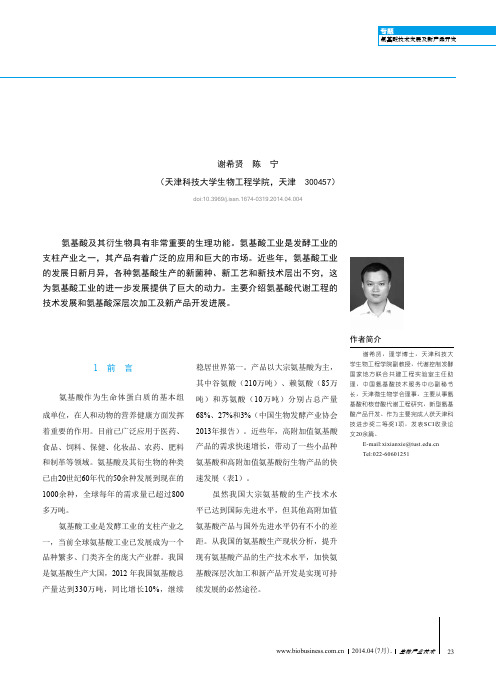
参考文献
Krömer J,Sorgenfrei O,Klopprogge K,et al. In-depth profiling of lysine-producing Corynebacterium glutamicum by combined analysis of the transcriptome,metabolome, and fluxome. J Bacteriol,2004,186:1769-1784.
氨基酸衍生物
D- 氨基酸、β- 氨基酸、短肽、 均聚氨基酸
发酵法、酶法转化 化学合成
医药、食品、 材料
参考文献
Dong X,Quinn P J,Wang X. Metabolic engineering of Escherichia coli and Corynebacterium glutamicum for the production of L-threonine. Biotechnol Adv,2011, 29:11-23.
氨基酸技术发展及新产品开发
氨基酸技术发展及新产品开发
谢希贤 陈 宁 (天津科技大学生物工程学院,天津 300457)
doi:10.3969/j.issn.1674-0319.2014.04.004
氨基酸及其衍生物具有非常重要的生理功能。氨基酸工业是发酵工业的 支柱产业之一,其产品有着广泛的应用和巨大的市场。近些年,氨基酸工业 的发展日新月异,各种氨基酸生产的新菌种、新工艺和新技术层出不穷,这 为氨基酸工业的进一步发展提供了巨大的动力。主要介绍氨基酸代谢工程的 技术发展和氨基酸深层次加工及新产品开发进展。
参考文献
Ohnishi J,Mitsuhashi S,Hayashi M,et al. A novel methodology employing Corynebacterium glutamicum genome information to generate a new L-lysine-producing mutant. Appl Microbiol Biotechnol,2002,58:217-223.
生物质基聚丁二酸丁二醇酯(PBS)应用研究进展
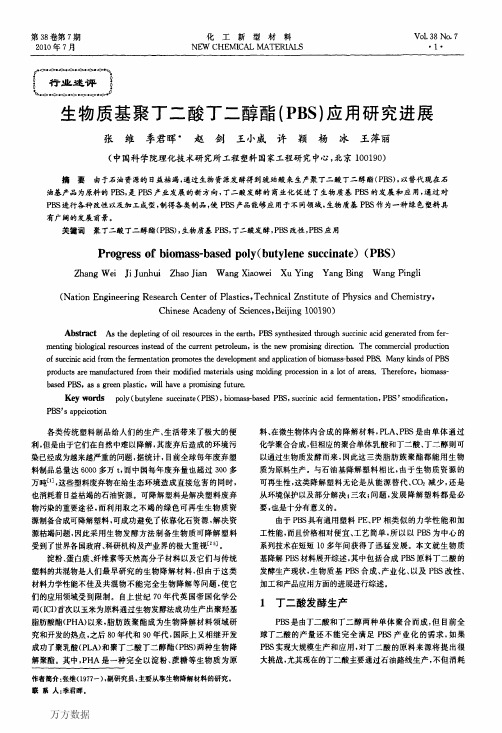
万方数据万方数据万方数据万方数据第7期张维等:生物质基聚丁二酸丁二醇酯(PBs)应用研究进展·5·LE’,synthesizedbypolycondensationreactioni,J].PolymDe-gradStab,1998,59:209—214.D73ChenGuoQiang.PlasticsfromBacteria:NaturalFunctionsandApplications,MicrobiologyMonographs,VoL14I-M].Get—many:Springer,2010,351—352.D83LeeSH.Limsw.Propertiesofpotentiallybiodegradablepolyestersof(succinicacid一1。
4-butanedi01)/(&methyltereph—thalate-1。
4-butanedi01)I,J3.PolymerInternational,1999,48(9):861—867.[19]WittaU,EinigbT,YamamotoM,eta1.Biodegradationofali—phatie-arornaticcopolyesters:evaluationofthefinalbiodegrad-abilityandecotoxicologicalimpactofdegradationintermediates口].Chemosphere,2001,44(2):289-299.[203KiHC。
ParkO0.Synthesis。
characterizationandbiodegrad—abilityofthebiodegradablealiphatic-aromaticrandomeopolyes—tersi'JJ.Polymer,2001,42(5):1849—1861.[213TserkiV,MatzinosP,PavlidouE.PanayiotoucBiodgrad—ablealiphaticpolyestersPartⅡ.Synthesisandcharacteriza—tionofchainextendedpoly(butylenesuccinate-co-butyleneadi-pate)[J].PolymDegradStab,2006,91(2):377—384.[22]TserkiV,MatzinosP,PavlidouE,VachliotisD,PanayiotouCBiodgradablealiphaticpolyestersPartI.Propertiesandbiodegradationofpoly(butylenesuccinate-co-butyleneadipate)[J].PolymDegradStab,2006,91(2):367—376.[233CaoAM,OkamuraT,IshiguroC,NakayamaK,InoueY。
微生物法生产香料化合物的研究
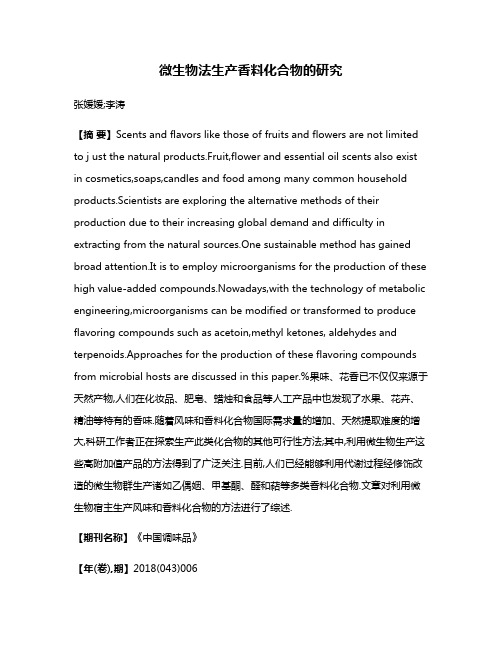
微生物法生产香料化合物的研究张媛媛;李涛【摘要】Scents and flavors like those of fruits and flowers are not limited to j ust the natural products.Fruit,flower and essential oil scents also exist in cosmetics,soaps,candles and food among many common household products.Scientists are exploring the alternative methods of their production due to their increasing global demand and difficulty in extracting from the natural sources.One sustainable method has gained broad attention.It is to employ microorganisms for the production of these high value-added compounds.Nowadays,with the technology of metabolic engineering,microorganisms can be modified or transformed to produce flavoring compounds such as acetoin,methyl ketones, aldehydes and terpenoids.Approaches for the production of these flavoring compounds from microbial hosts are discussed in this paper.%果味、花香已不仅仅来源于天然产物,人们在化妆品、肥皂、蜡烛和食品等人工产品中也发现了水果、花卉、精油等特有的香味.随着风味和香料化合物国际需求量的增加、天然提取难度的增大,科研工作者正在探索生产此类化合物的其他可行性方法;其中,利用微生物生产这些高附加值产品的方法得到了广泛关注.目前,人们已经能够利用代谢过程经修饰改造的微生物群生产诸如乙偶姻、甲基酮、醛和萜等多类香料化合物.文章对利用微生物宿主生产风味和香料化合物的方法进行了综述.【期刊名称】《中国调味品》【年(卷),期】2018(043)006【总页数】3页(P180-182)【关键词】香料化合物;微生物生产法;乙偶姻;醛;甲基酮;萜【作者】张媛媛;李涛【作者单位】青岛科技大学化工学院,山东青岛 266000;青岛科技大学化工学院,山东青岛 266000【正文语种】中文【中图分类】TS209从化学的角度来看,香料分子由许多独特的结构和官能团组成,这些化学特性赋予它们各种不同的气味;除了食品和饮料,香料工业还囊括香水、清洁产品、肥皂、洗涤剂和口腔保健产品等。
代谢工程改造大肠杆菌合成L-组氨酸
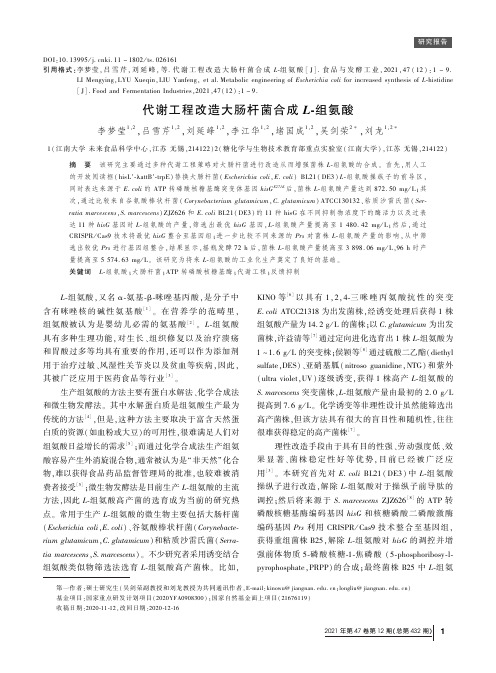
本研究
B8
B1 harboring pBSG11-hisG( C. glutamicum) G233H / T23Q
本研究
B9
B1 harboring pBSG11-hisG( C. glutamicum) G233H / T23Q / N215I 本研究
B10
B1 harboring pBSG11-hisG( C. glutamicum) S143F / (209 - 281 本研究
B11
B1 harboring pBSG11-hisG(S. marcescens)
本研究
B12
B1 harboring pBSG11-hisG( S. marcescens) E271K
本研究
B13
B1 harboring pBSG11-hisGA10T
本研究
B14
B1 harboring pBSG11-hisGC149Y
代谢工程改造大肠杆菌合成 L-组氨酸
李梦莹1,2 ,吕雪芹1,2 ,刘延峰1,2 ,李江华1,2 ,堵国成1,2 ,吴剑荣2∗ ,刘龙1,2∗
1( 江南大学 未来食品科学中心,江苏 无锡,214122)2( 糖化学与生物技术教育部重点实验室( 江南大学) ,江苏 无锡,214122)
摘 要 该研究主要通过多种代谢工程策略对大肠杆菌进行改造从而增强菌株 L-组氨酸的合成。 首先,用人工 的开放阅读框( hisL′-λattB′-trpE) 替换大肠杆菌( Escherichia coli,E. coli) BL21 ( DE3 ) L-组 氨 酸 操 纵 子 的 前 导 区, 同时表达来源于 E. coli 的 ATP 转磷酸核糖基酶突变体基因 hisGE271K 后,菌株 L-组氨酸产量达到 872. 50 mg / L;其 次,通过比较来自谷氨 酸 棒 状 杆 菌 ( Corynebacterium glutamicum,C. glutamicum) ATCC130132、粘 质 沙 雷 氏 菌 ( Serratia marcescens,S. marcescens) ZJZ626 和 E. coli BL21( DE3) 的 11 种 hisG 在不同抑制物浓度下的酶活力以及过 表 达 11 种 hisG 基因时 L-组氨酸 的 产 量,筛 选 出 最 优 hisG 基 因,L-组 氨 酸 产 量 提 高 至 1 480. 42 mg / L;然 后,通 过 CRISPR / Cas9 技术将最优 hisG 整合至基因组;进一步比 较 不 同 来 源 的 Prs 对 菌 株 L-组 氨 酸 产 量 的 影 响,从 中 筛 选出较优 Prs 进行基因组整合,结果显示,摇瓶发酵 72 h 后,菌株 L-组氨酸产量提高至 3 898. 06 mg / L,96 h 时产 量提高至 5 574. 63 mg / L。 该研究为将来 L-组氨酸的工业化生产奠定了良好的基础。 关键词 L-组氨酸;大肠杆菌;ATP 转磷酸核糖基酶;代谢工程;反馈抑制
酿酒酵母木糖代谢工程中辅酶
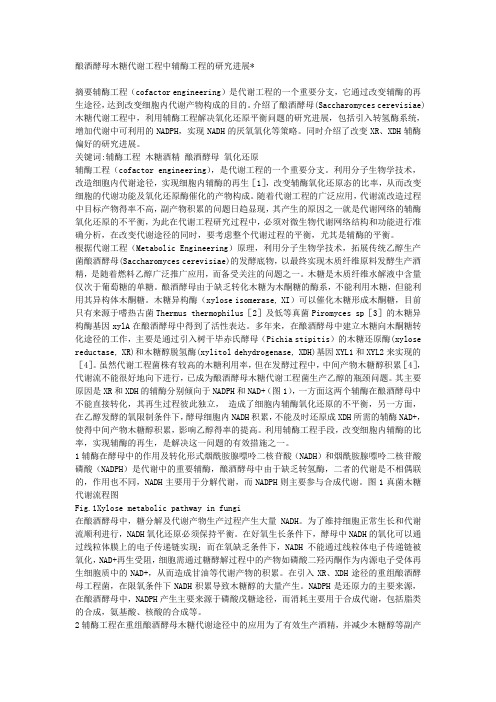
酿酒酵母木糖代谢工程中辅酶工程的研究进展*摘要辅酶工程(cofactor engineering)是代谢工程的一个重要分支,它通过改变辅酶的再生途径,达到改变细胞内代谢产物构成的目的。
介绍了酿酒酵母(Saccharomyces cerevisiae)木糖代谢工程中,利用辅酶工程解决氧化还原平衡问题的研究进展,包括引入转氢酶系统,增加代谢中可利用的NADPH,实现NADH的厌氧氧化等策略。
同时介绍了改变XR、XDH辅酶偏好的研究进展。
关键词:辅酶工程木糖酒精酿酒酵母氧化还原辅酶工程(cofactor engineering),是代谢工程的一个重要分支。
利用分子生物学技术,改造细胞内代谢途径,实现细胞内辅酶的再生[1],改变辅酶氧化还原态的比率,从而改变细胞的代谢功能及氧化还原酶催化的产物构成。
随着代谢工程的广泛应用,代谢流改造过程中目标产物得率不高,副产物积累的问题日趋显现,其产生的原因之一就是代谢网络的辅酶氧化还原的不平衡,为此在代谢工程研究过程中,必须对微生物代谢网络结构和功能进行准确分析,在改变代谢途径的同时,要考虑整个代谢过程的平衡,尤其是辅酶的平衡。
根据代谢工程(Metabolic Engineering)原理,利用分子生物学技术,拓展传统乙醇生产菌酿酒酵母(Saccharomyces cerevisiae)的发酵底物,以最终实现木质纤维原料发酵生产酒精,是随着燃料乙醇广泛推广应用,而备受关注的问题之一。
木糖是木质纤维水解液中含量仅次于葡萄糖的单糖。
酿酒酵母由于缺乏转化木糖为木酮糖的酶系,不能利用木糖,但能利用其异构体木酮糖。
木糖异构酶(xylose isomerase, XI)可以催化木糖形成木酮糖,目前只有来源于嗜热古菌Thermus thermophilus[2]及低等真菌Piromyces sp[3]的木糖异构酶基因xylA在酿酒酵母中得到了活性表达。
多年来,在酿酒酵母中建立木糖向木酮糖转化途径的工作,主要是通过引入树干毕赤氏酵母(Pichia stipitis)的木糖还原酶(xylose reductase, XR)和木糖醇脱氢酶(xylitol dehydrogenase, XDH)基因XYL1和XYL2来实现的[4]。
以菊粉为底物全细胞催化生产甘露醇

以菊粉为底物全细胞催化生产甘露醇罗希;曹海龙;张卉妍;李悝悝;张春枝【摘要】A whole-cell biotransformation system E.coliBL21(DE3)/pRSFDuet-mdh-fdh pZY507glf for mannitol production were established through the mannitol dehydrogenase (mdh) derived from Leuconostoc mesenteroides and the formate dehydrogenase gene (fdh) derived from Mycobacterium vaccae pRSFDuet-mdh-fdh with the glucose facilitator protein (glf) pZY507glf co-expressed in E.coli BL21(DE3).The yield of mannitol could reach to 0.91 g/g under the optimum conditions of pH 6.5 a t 30 ℃.The yield of mannitol could reach to 0.93 g/g by whole catalyst with high activity inulinase.%将Leuconostoc mesenteroides来源的甘露醇脱氢酶(mdh)及Mycobacterium vaccae来源的甲酸脱氢酶(fdh)的共表达载体pRSFDuet|mdh|fdh,与葡萄糖辅助蛋白(glf)的表达载体pZY507glf共转入大肠杆菌BL21(DE3)中,成功构建了一个可将果糖转化为甘露醇的全细胞催化剂E.coli BL21(DE3)/pRSFDuet|mdh|fdh pZY507glf.该全细胞催化剂在pH 6.5、温度30 ℃时,具有最高的转化效率,甘露醇的产率可达到0.91 g/g.通过与高活力的菊粉酶协同作用,甘露醇的产率可达到0.93 g/g.【期刊名称】《大连工业大学学报》【年(卷),期】2017(036)004【总页数】5页(P235-239)【关键词】甘露醇;生物转化法;菊粉;全细胞催化【作者】罗希;曹海龙;张卉妍;李悝悝;张春枝【作者单位】大连工业大学生物工程学院, 辽宁大连 116034;中国科学院大连化学物理研究所, 辽宁大连 116023;中国科学院大连化学物理研究所, 辽宁大连116023;中国科学院大连化学物理研究所, 辽宁大连 116023;大连工业大学生物工程学院, 辽宁大连 116034【正文语种】中文【中图分类】TS202.1;Q819甘露醇是一种六元糖醇,在医药、食品、化工和轻工等领域具有十分广泛的应用[1-3]。
微生物合成2,3-丁二醇的代谢工程

微生物合成2,3-丁二醇的代谢工程童颖佳;邬文嘉;彭辉;刘陆罡;黄和;纪晓俊【摘要】2,3-butanediol (2,3-BD), which is considered as an important microbial metabolite, has been widely used in many fields such as food, medicine, chemical, and so on. Microbial 2,3-BD production has a history of more than 100 years, but the low efficiency of microbial 2,3-BD accumulation has constrained its process in biological manufacturing industrialization. Optimization of microbial metabolic pathway with the theory and method of metabolic engineering is expected to solve this problem. The objective of this paper is to review the state-of-the-art strain transformation and construction strategies in microbial synthesis of 2,3-BD, including overexpressing genes encoding for key enzymes in the 2,3-BD metabolic pathway, knocking out the metabolic bypass way genes, and using the methods of cofactor engineering in redesigning and reasonable transformation of the natural strains’ metabolic network. Besides that, the using of synthetic biology in constructing brand new 2,3-BD pathways in model strains, such as Escherichia coli, Saccharomyces cerevisiae and Cyanobacteria, in order to enhance the yield or chiral 2,3-BD production in microorganisms is also introduced in this review. Finally, the future research direction is prospected, and the guidelines to develop high-efficiency microbial cell factories by advanced synthetic biology methods to achieve the optimal allocation of the intracellular metabolic flow are also proposed.%2,3-丁二醇(2,3-BD)是一种重要的微生物代谢产物,广泛应用于食品、医药、化工等多个领域。
代谢工程改造大肠杆菌合成β-丙氨酸
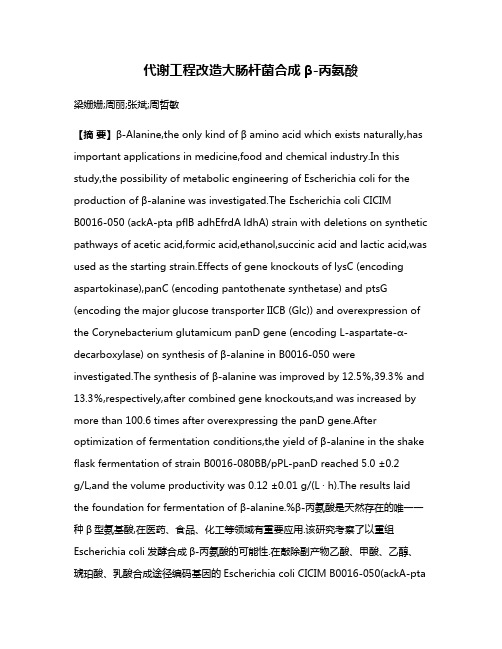
代谢工程改造大肠杆菌合成β-丙氨酸梁姗姗;周丽;张斌;周哲敏【摘要】β-Alanine,the only kind of β amino acid which exists naturally,has important applications in medicine,food and chemical industry.In this study,the possibility of metabolic engineering of Escherichia coli for the production of β-alanine was investigated.The Escherichia coli CICIMB0016-050 (ackA-pta pflB adhEfrdA ldhA) strain with deletions on synthetic pathways of acetic acid,formic acid,ethanol,succinic acid and lactic acid,was used as the starting strain.Effects of gene knockouts of lysC (encoding aspartokinase),panC (encoding pantothenate synthetase) and ptsG (encoding the major glucose transporter IICB (Glc)) and overexpression of the Corynebacterium glutamicum panD gene (encoding L-aspartate-α-decarboxylase) o n synthesis of β-alanine in B0016-050 were investigated.The synthesis of β-alanine was improved by 12.5%,39.3% and 13.3%,respectively,after combined gene knockouts,and was increased by more than 100.6 times after overexpressing the panD gene.After optimiza tion of fermentation conditions,the yield of β-alanine in the shake flask fermentation of strain B0016-080BB/pPL-panD reached 5.0 ±0.2g/L,and the volume productivity was 0.12 ±0.01 g/(L · h).The results laid the foundation for fermentation of β-alanine.%β-丙氨酸是天然存在的唯一一种β型氨基酸,在医药、食品、化工等领域有重要应用.该研究考察了以重组Escherichia coli发酵合成β-丙氨酸的可能性.在敲除副产物乙酸、甲酸、乙醇、琥珀酸、乳酸合成途径编码基因的Escherichia coli CICIM B0016-050(ackA-ptapflB adhE frdA ldhA)菌株中,考察叠加敲除β-丙氨酸的竞争途径天冬氨酸激酶、泛酸合成酶和葡萄糖转运蛋白(EⅡCBGlc)的编码基因(lysC、panC、ptsG)以及过表达来源于Corynebacterium glutamicum的panD基因对合成β-丙氨酸的影响.结果表明,叠加敲除上述基因后,β-丙氨酸的合成量依次提高了12.5%、39.3%和13.3%;过量表达panD基因,β-丙氨酸合成量提高了86.2倍;经发酵条件优化,菌株B0016-080BB/pPL-panD摇瓶发酵可合成(5.0±0.2) g/L β-丙氨酸,体积生产强度达到(0.12±0.01) g/(L·h).该结果为发酵法合成β-丙氨酸奠定了基础.【期刊名称】《食品与发酵工业》【年(卷),期】2017(043)005【总页数】6页(P13-18)【关键词】β-丙氨酸;大肠杆菌;L-天冬氨酸-α-脱羧酶;代谢工程;基因敲除【作者】梁姗姗;周丽;张斌;周哲敏【作者单位】江南大学生物工程学院,工业生物技术教育部重点实验室,江苏无锡,214122;江南大学生物工程学院,工业生物技术教育部重点实验室,江苏无锡,214122;江南大学生物工程学院,工业生物技术教育部重点实验室,江苏无锡,214122;江南大学生物工程学院,工业生物技术教育部重点实验室,江苏无锡,214122【正文语种】中文β-丙氨酸即3-氨基丙酸,是自然界中唯一存在的β型氨基酸,近年来,在医药、化工、食品、环境等领域的作用日渐突出[1]。
生物法合成戊二胺研究进展_李东霞
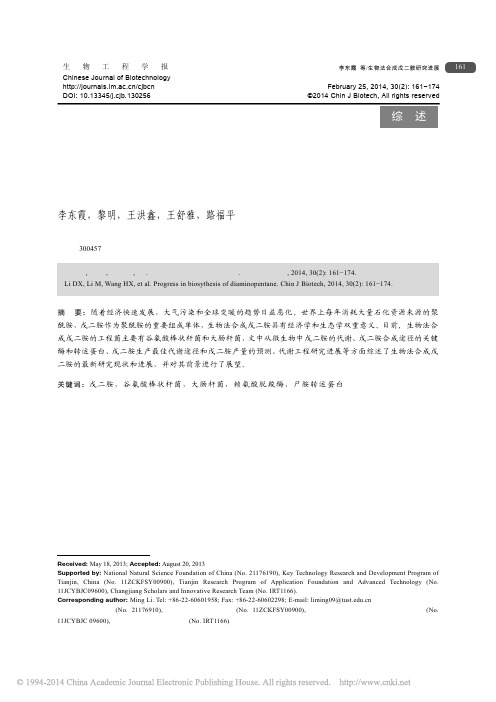
李东霞 等/生物法合成戊二胺研究进展Chinese Journal of Biotechnology/cjbcn February 25, 2014, 30(2): 161−174 DOI: 10.13345/j.cjb.130256 ©2014 Chin J Biotech, All rights reservedReceived : May 18, 2013; Accepted : August 20, 2013Supported by : National Natural Science Foundation of China (No. 21176190), Key Technology Research and Development Program of Tianjin, China (No. 11ZCKFSY00900), Tianjin Research Program of Application Foundation and Advanced Technology (No. 11JCYBJC09600), Changjiang Scholars and Innovative Research Team (No. IRT1166).Corresponding author : Ming Li. Tel: +86-22-60601958; Fax: +86-22-60602298; E-mail: liming09@国家自然科学基金(No. 21176910), 天津市科技支撑计划 (No. 11ZCKFSY00900), 天津市应用基础及前沿技术研究计划(No. 11JCYBJC 09600), 长江学者与创新团队项目(No. IRT1166) 资助。
生物工程学报生物法合成戊二胺研究进展李东霞,黎明,王洪鑫,王舒雅,路福平天津科技大学生物工程学院 工业发酵微生物教育部重点实验室 国家工业酶工程实验室 天津市工业微生物重点实验室,天津 300457李东霞, 黎明, 王洪鑫, 等. 生物法合成戊二胺研究进展. 生物工程学报, 2014, 30(2): 161−174.Li DX, Li M, Wang HX, et al. Progress in biosythesis of diaminopentane. Chin J Biotech, 2014, 30(2): 161−174.摘 要: 随着经济快速发展,大气污染和全球变暖的趋势日益恶化。
大肠杆菌代谢工程生产芳香族化合物研究进展
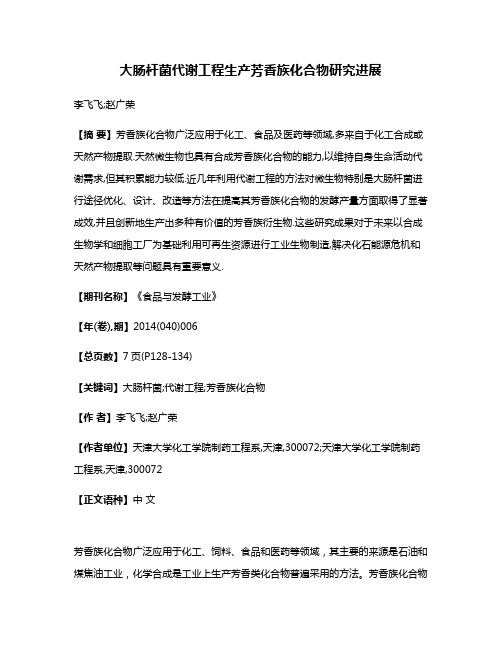
大肠杆菌代谢工程生产芳香族化合物研究进展李飞飞;赵广荣【摘要】芳香族化合物广泛应用于化工、食品及医药等领域,多来自于化工合成或天然产物提取.天然微生物也具有合成芳香族化合物的能力,以维持自身生命活动代谢需求,但其积累能力较低.近几年利用代谢工程的方法对微生物特别是大肠杆菌进行途径优化、设计、改造等方法在提高其芳香族化合物的发酵产量方面取得了显著成效,并且创新地生产出多种有价值的芳香族衍生物.这些研究成果对于未来以合成生物学和细胞工厂为基础利用可再生资源进行工业生物制造,解决化石能源危机和天然产物提取等问题具有重要意义.【期刊名称】《食品与发酵工业》【年(卷),期】2014(040)006【总页数】7页(P128-134)【关键词】大肠杆菌;代谢工程;芳香族化合物【作者】李飞飞;赵广荣【作者单位】天津大学化工学院制药工程系,天津,300072;天津大学化工学院制药工程系,天津,300072【正文语种】中文芳香族化合物广泛应用于化工、饲料、食品和医药等领域,其主要的来源是石油和煤焦油工业,化学合成是工业上生产芳香类化合物普遍采用的方法。
芳香族化合物也广泛分布于自然界,是各种生物的初级和次级代谢产物,所以也有一部分芳香族产品是通过生物法获得的。
近年来,随着环保要求的提高和化石能源的减少,利用生物法合成芳香族目标化合物成为研究的热点,其中微生物发酵法是通过优良的微生物菌种在合适的条件下以葡萄糖、甘油等可再生原料发酵积累芳香族化合物。
目前对于微生物中芳香族化合物的合成途径和调控机理研究最多且阐述最为清楚的是大肠杆菌。
大肠杆菌体内芳香族化合物的合成主要通过莽草酸途径(shikimate pathway)(图1)和其下游芳香族氨基酸进一步衍生化实现。
由于大肠杆菌自身积累芳香族化合物能力很低,只有代谢途径优化改造才能更好的实现目标产物的发酵生产。
近几年通过大肠杆菌代谢工程方法生产芳香族化合物取得了显著成效,极大地提高了目标化合物的合成积累能力,这为日后研究的进一步深入和工业化生产奠定了良好的基础。
产丁醇大肠杆菌工程菌的构建

产丁醇大肠杆菌工程菌的构建林丽华;郭媛;裴建新;庞浩;黄日波【摘要】[目的]为了在大肠杆菌(Escherichia coli)中导入改良的丁醇合成途径,使非生产菌株大肠杆菌具备产丁醇的能力.[方法]克隆大肠杆菌乙酰转移酶基因atoB 和丙酮丁醇梭菌(Clostridium acetobutylicum)丁醇合成途径关键酶基因(crt、hbd、adhE),构建多顺反子表达质粒pSE380-atoB-adhE-crt-hbd;克隆齿垢密螺旋体(Treponema denticola)反式烯酰辅酶A还原酶基因ter,构建表达质粒pSTV29-ter,并将双质粒导入到大肠杆菌.[结果]构建的工程菌能半厌氧发酵产微量丁醇,产量为0.08g/L.[结论]大肠杆菌中的丁醇合成途径导入成功,构建了产丁醇的大肠杆菌工程菌.【期刊名称】《广西科学》【年(卷),期】2014(021)001【总页数】5页(P42-46)【关键词】正丁醇;大肠杆菌;丙酮丁醇梭菌;齿垢密螺旋体;半厌氧发酵【作者】林丽华;郭媛;裴建新;庞浩;黄日波【作者单位】广西科学院,非粮生物质酶解国家重点实验室,国家非粮生物质能源工程技术研究中心,广西生物质产业化工程院,广西生物炼制重点实验室,广西南宁530007;广西大学生命科学与技术学院,广西南宁 530004;广西科学院,非粮生物质酶解国家重点实验室,国家非粮生物质能源工程技术研究中心,广西生物质产业化工程院,广西生物炼制重点实验室,广西南宁530007;广西科学院,非粮生物质酶解国家重点实验室,国家非粮生物质能源工程技术研究中心,广西生物质产业化工程院,广西生物炼制重点实验室,广西南宁530007;广西科学院,非粮生物质酶解国家重点实验室,国家非粮生物质能源工程技术研究中心,广西生物质产业化工程院,广西生物炼制重点实验室,广西南宁530007;广西大学生命科学与技术学院,广西南宁 530004;广西科学院,非粮生物质酶解国家重点实验室,国家非粮生物质能源工程技术研究中心,广西生物质产业化工程院,广西生物炼制重点实验室,广西南宁530007;广西大学生命科学与技术学院,广西南宁 530004【正文语种】中文【中图分类】Q78【研究意义】丁醇是一种重要的化工原料和新型的生物燃料,国内外市场对丁醇的需求量逐年上升。
- 1、下载文档前请自行甄别文档内容的完整性,平台不提供额外的编辑、内容补充、找答案等附加服务。
- 2、"仅部分预览"的文档,不可在线预览部分如存在完整性等问题,可反馈申请退款(可完整预览的文档不适用该条件!)。
- 3、如文档侵犯您的权益,请联系客服反馈,我们会尽快为您处理(人工客服工作时间:9:00-18:30)。
Metabolic Engineering4,217–229(2002)doi:10.1006/mben.2002.0227Metabolic Engineering of Escherichia coli:Increase of NADH Availability by Overexpressing an NADþ-Dependent Formate DehydrogenaseSusana J.Berrıos-Rivera,n George N.Bennett,w and Ka-Yiu San n,1n Department of Bioengineering and Chemical Engineering;andw Department of Biochemistry and Cell Biology,Rice University,Houston,TexasReceived December4,2001;accepted April29,2002Metabolic engineering studies have generally focused on manipulating enzyme levels through either the amplification, addition,or deletion of a particular pathway.However,with cofactor-dependent production systems,once the enzyme levels are no longer limiting,cofactor availability and the ratio of the reduced to oxidized form of the cofactor can become limiting. Under these situations,cofactor manipulation may become crucial in order to further increase system productivity. Although it is generally known that cofactors play a major role in the production of different fermentation products,their role has not been thoroughly and systematically studied.However, cofactor manipulations can potentially become a powerful tool for metabolic engineering.Nicotinamide adenine dinucleotide (NAD)functions as a cofactor in over300oxidation–reduction reactions and regulates various enzymes and genetic processes. The NADH/NAD+cofactor pair plays a major role in microbial catabolism,in which a carbon source,such as glucose, is oxidized using NAD+producing reducing equivalents in the form of NADH.It is crucially important for continued cell growth that NADH be oxidized to NAD+and a redox balance be achieved.Under aerobic growth,oxygen is used as thefinal electron acceptor.While under anaerobic growth,and in the absence of an alternate oxidizing agent,the regeneration of NAD+is achieved through fermentation by using NADH to reduce metabolic intermediates.Therefore,an increase in the availability of NADH is expected to have an effect on the metabolic distribution.This paper investigates a genetic means of manipulating the availability of intracellular NADH in vivo by regenerating NADH through the heterologous expression of an NAD+-dependent formate dehydrogenase.More specifically, it explores the effect on the metabolic patterns in Escherichia coli under anaerobic and aerobic conditions of substituting the native cofactor-independent formate dehydrogenase(FDH)by an NAD+-dependent FDH from Candida boidinii.The over-expression of the NAD+-dependent FDH doubled the maximum yield of NADH from2to4mol NADH/mol glucose consumed, increased thefinal cell density,and provoked a significant change in thefinal metabolite concentration pattern both anaerobically and aerobically.Under anaerobic conditions,the production of more reduced metabolites was favored,as evidenced by a dramatic increase in the ethanol-to-acetate ratio. Even more interesting is the observation that during aerobic growth,the increased availability of NADH induced a shift to fermentation even in the presence of oxygen by stimulating pathways that are normally inactive under these condi-tions.#2002Elsevier Science(USA)Key Words:cofactor;redox system;NADH regeneration; FDH;ethanol.INTRODUCTIONThe metabolic pathways leading to the production of most industrially important compounds involve reduction–oxidation(red–ox)reactions.Biosynthetic transformations involving red–ox reactions also offer a considerable potential for the production offine chemicals over conventional chemical processes,especially those requiring stereospecificity.Nicotinamide adenine dinucleotide(NAD)plays a central role in cellular metabolism by functioning as a cofactor in over300red–ox reactions(Foster et al.,1990). In addition,studies have shown that the NADH=NADþcofactor pair has a regulatory effect on the expression of some genes and the activity of certain enzymes.Examples include,among others,the induction by NADH of the expression of the adhE gene that encodes the enzyme alcohol dehydrogenase(Leonardo et al.,1993,1996),which catalyzes the production of ethanol during fermentation; the inhibition of high NADH=NADþratios on the pyruvate dehydrogenase complex(De Graef et al.,1999); and the regulation by the NADH=NADþratio on the shift between oxidation or reduction of l-lactaldehyde (Baldoma and Aguilar,1988).During catabolism,a cell oxidizes a carbon source,such as glucose,utilizing NADþas a cofactor and producing1To whom correspondence and reprint requests should be addressed. Fax:(713)348-5877.E-mail:ksan@.reducing equivalents in the form of NADH.The cellregenerates NAD þfrom NADH to achieve a redox balance.Under aerobic growth,oxygen is used as the final electron acceptor.While under anaerobic growth and in the absence of an alternate oxidizing agent,the regenera-tion of NADH is achieved through fermentation,where NADH is used to reduce metabolic intermediates and to regenerate NAD þ(Fig.1).Therefore,in fermentation,alterations in the availability of NADH are expected to have a profound effect in the whole metabolic network.The influence of cofactors in metabolic networks has been evidenced by studies in which the NADH =NAD þratio has been altered by feeding carbon sources with different oxidation states (Alam and Clark,1989;Leonar-do et al.,1996);by supplementing anaerobic growth with different electron acceptors,such as fumarate and nitrate (De Graef et al.,1999);or by expressing an enzyme like NADH oxidase (Lopez de Felipe et al.,1998).Other previous efforts to manipulate NADH levels have included the addition of electron dye carriers (Park and Zeikus,1999)and the variation of oxidoreduction potential conditions (Riondet et al.,2000).The effective regeneration of used cofactors is critical in industrial cofactor-dependent production systems due to the high cost of cofactors such as NAD.In enzyme bioreactors,NAD þ-dependent formate dehydrogenase (FDH;EC 1.2.1.2)from methylotrophic yeast and bacteria is extensively used to regenerate NADH from NAD þin vitro .FDH catalyzes the practically irreversible oxida-tion of formate to CO 2and the simultaneous reduction of NAD þto NADH.Cofactor regeneration has been successfully applied in vitro for the production of optically active amino acids (Kragl et al.,1996;Galkin et al.,1997),chiral hydroxy acids,esters,alcohols,and other fine chemicals synthesized by different dehydrogenases (Hum-mel and Kula,1989;Tishkov et al.,1999).EthanolLactateGlucoseGlucose-6-PPEP PyruvateAcetyl-P ADP ATPCO 2FIG.1.Central anaerobic metabolic pathway of Escherichia coli showing generation of NADH and regeneration of NAD þ;including the new NAD þ-dependent formate dehydrogenase (FDH)from Candida boidinii .Metabolic Engineering 4,217–229(2002)Berrı´os-Rivera,Bennett,and San doi:10.1006/mben.2002.0227In spite of these advances,biotransformation with whole cells is still the preferred method for the synthesis of most cofactor-dependent products industrially.In these systems,the cell naturally regenerates the cofactor.However,the enzyme of interest has to compete for the required cofactor with a large number of other enzymes within the cell.Therefore,in cofactor-dependent production systems,after the enzymes of interest have been overexpressed,the availability of the required form of the cofactor (reduced or oxidized)can become limiting,making cofactor manipulations crucial for optimal production.Although it is generally known that cofactors play a major role in the production of different fermentation products,their role has not been thoroughly and system-atically studied.Instead,metabolic engineering studies have focused on manipulating enzyme levels through the amplification,addition or deletion of a particular pathway.However,cofactor manipulations can potentially become a powerful tool for metabolic engineering.This paper investigates a genetic means of manipulating the availability of intracellular NADH in vivo by regener-ating NADH through the heterologous expression of an NAD þ-dependent formate dehydrogenase.We have devel-oped a novel approach to increase the availability of intracellular NADH in vivo through metabolic and genetic engineering.In this approach,we overexpress a biologically active NAD þ-dependent formate dehydrogenase (FDH)from Candida boidinii in Escherichia coli .In the presence ofthis newly introduced formate dehydrogenase pathway,one mole of NADH will be formed when one mole of formate is converted to carbon dioxide (Fig.2).In contrast,the native formate dehydrogenase converts formate to CO 2and H 2with no cofactor involvement.The new system allows the cells to retain the reducing power that otherwise will be lost by release of formate or hydrogen in the native pathway.The functionality of the new system for NADH regeneration was successfully demonstrated in anaerobic tubes and aerobic shake flask experiments.MATERIALS AND METHODSBacterial Strains and PlasmidsTable 1describes the strains and plasmids used in this study.The strain BS1was constructed from the strain GJT001by inactivating the native formate dehydrogenase.Plasmid pSBF2contains the fdh1gene from the yeast Candida boidinii under the control of the lac promoter.The fdh1gene encodes an NAD þ-dependent formate dehydro-genase (FDH)that converts formate to CO 2with the regeneration of NADH from NAD þ:In contrast,the native formate dehydrogenase converts formate to CO 2and H 2with no cofactor involvement (refer to Fig.2).The construction of the strains and plasmids is summarized below.H 2PyruvateAcetyl-CoAFormate CO 2+CO PDHNAD +NADHCO 2original NAD independent pathway(FDHF: formate dehydrogenase, NAD independent) Newly added NAD+ dependent pathway(FDH1: NAD +-dependent formate dehydrogenase FDH1 encoded by fdh1 from Candida boidinii) NAD +- dependent pathway active under aerobic conditions (PDH: pyruvate dehydrogenase)FIG.2.Diagram illustrating the native cofactor-independent formate degradation pathway and the newly introduced NAD þ-dependent pathway.Also shown is the conversion of pyruvate to acetyl-CoA and formate by pyruvate formate lyase (PFL)under anaerobic conditions and to acetyl-CoA and CO 2by pyruvate dehydrogenase (PDH)under aerobic conditions.Metabolic Engineering of E.coliMetabolic Engineering 4,217–229(2002)doi:10.1006/mben.2002.0227Strain BS1.Strain BS1was constructed by replacingthe wild-type fdhF gene with an fdhF ’-‘lacZ fusion by a P1vir-mediated phage transduction with E.coli M9s as donor and E.coli GJT001as recipient.The P1phage transduction was performed following standard protocols (Maniatis et al.,1989).Ampicillin resistant transductants were selected for further analysis.The lack of formate dehy-drogenase activity was confirmed by a previously described method with minor modifications (Mandrand-Berthelot et al.,1978).Briefly,wild-type and transduced GJT001were grown on glucose minimal media plates for 2days in an anaerobic chamber under an atmosphere of H 2and CO 2:An overlay solution composed of 0.6%agar,2mg =ml benzyl viologen,0:25M sodium formate and 25mM KH 2PO 4(pH 7.0)was poured over the plates.The presence of formate dehydrogenase activity in the wild-type GJT001was evidenced by a change in the color of the colonies,which turned purple.The colonies of the transductants remained white,thus indicating the lack of formate dehydrogenase activity.The presence of the mutation of fdh F in the transductants was also confirmed by PCR.Primers complementary to the ends of the fdh F gene (forward primer:50-GATTAACTGGAGCGA GACC-30;reverse primer:50-TCCGAAAGGAGGCTG TAG-30)(Zinoni et al.,1986)were used to amplify this gene in both wild-type and transduced GJT001.The disruption of the fdh F gene in the transduced strain was confirmed by the absence of a PCR product as opposed to a 2.2-kb product corresponding to the complete gene in the wild-type strain.Plasmid pSBF2.Plasmid pFDH1was kindly pro-vided by Dr.Y.Sakai (Sakai et al.,1997).It contains a3kb EcoRI insert containing the fdh1gene from the yeast Candida boidinii in pBluescriptII SK +.The fdh1gene in pFDH1is under the control of its native promoter.Preliminary experiments with pFDH1showed no FDH activity,suggesting that fdh1from the yeast was not properly expressed in E.coli .For this reason,the open reading frame of the fdh gene from C.boidinii was amplified by PCR and placed under the control of the lac promoter for overexpression in E.coli .XL-PCR was performed using the GeneAmp XL PCR kit from PE Applied Biosystems following the manufac-turer’s protocol.This kit was chosen because of the proofreading ability of the enzyme rTth DNA polymerase,which not only promotes efficient DNA synthesis but also corrects nucleotide misincorporations.Plasmid pFDH1was used as a template and the following were used as forward and reverse primers,respectively:50-GCGGAATTCAGGAGGAATTTAAA ATG AAGATCG TTTTAGTCTTATATGATGCT-30;50-CGCGGATCC TTA TTTCTTATCGTGTTTACCGTAAGC-30:An EcoRI and a BamHI site were inserted in the forward and reverse primers,respectively,as represented by the underlined regions.The program used for the PCR reaction consisted of an initial denaturation step at 941C for 1min and 30s followed by 18cycles of denaturation at 941C for 30s and combined annealing/extension at 55–661C for 5min :This was followed by 12cycles in which the annealing/extension time was increased by 15s in each cycle until it reached 8min :A final step at 721C for 10min concluded the PCR.The PCR product was verified by agarose gel electro-phoresis.It was purified from the reaction mixture andTABLE 1List of Strains and Plasmids Used in This StudySignificant genotypeReferences StrainsGJT001Spontaneous cadR mutant of MC4100,Sm RTolentino et al.(1992)D H 10BCloning hostM9s MC4100f ðfdhF 0-0lacZ Þ;Ap R Pecher et al.(1983)BS1GJT001f ðfdhF 0-0lacZ Þ;Ap RThis studyPlasmids pUC18Cloning vector,Ap RpDHK29,pDHK30Control,cloning vector,Km RPhillips et al.(2000)pFDH1fdh1in pBluescriptII SK+Sakai et al.(1997)pUCFDH Intermediate plasmid,fdh1in pUC18,Ap R This study pSBF2fdh1in pDHK30,Km RThis studyMetabolic Engineering 4,217–229(2002)Berrı´os-Rivera,Bennett,and San doi:10.1006/mben.2002.0227concentrated following the protocol of the StrataPrep TM PCR Purification Kit(Stratagene,La Jolla,CA).The purified fdh PCR product and the vector pUC18were digested with EcoRI and BamHI.Both fragments were ligated to form pUCFDH.The ligation product was transformed into E.coli strain DH10B.White colonies from Ap/Xgal/IPTG plates were selected for further analysis and minipreps were performed.Insertion of the fdh gene was confirmed by agarose gel electrophoresis after digestion with EcoRI/SalI.Plasmid pUCFDH served as an intermediate vector to facilitate the insertion of the fdh gene into pDHK30in the right orientation.It was ultimately desired to have the fdh gene in the pDHK30backbone because it is a high copy number plasmid with kanamycin resistance,which will not interfere with the ampicillin resistance of the BS1strain. An additional advantage of the pDHK30vector is that it can be co-transformed in a two-plasmid system together with the most common high copy number vectors bearing a ColE1origin.The intermediate plasmid containing fdh(pUCFDH), and pDHK30were digested with EcoRI/XbaI and ligated to obtain plasmid pSBF2.The ligation product was transformed into DH10Band white colonies from Km/ Xgal plates were analyzed.Minipreps were obtained and analyzed by agarose gel electrophoresis after digestion with EcoRI/XbaI.An appropriate plasmid was selected and transformed both into GJT001and the fdhÀstrain BS1. Strain GJT001was also transformed with pDHK29,and BS1was transformed with pDHK30to serve as negative controls.FDH activity assayThe FDH activity of strains GJT001(pSBF2)and BS1 (pSBF2)was determined as described below.Cultures were grown overnight in LBmedia supplemen-ted with20g=L glucose and100mg=L kanamycin under anaerobic conditions.The cultures were inoculated with 100m l of a5ml overnight LBculture and grown in a shaker at371C and250rpm:Cells were harvested by centrifugation of20ml of culture at4000g and41C for 10min:The pellet was suspended in10ml of10-mM sodium phosphate buffer(refrigerated)at pH7.5with 0:1M b-mercaptoethanol and centrifuged as described above.The cells were resuspended in10ml of10-mM sodium phosphate buffer(refrigerated)at pH7.5with 0:1M b-mercaptoethanol and sonicated for6min in an ice bath(Sonicator:Heat System Ultrasonics,Inc.Model W-255;Settings:60%cycle,max.power¼8).The sonicated cells were centrifuged at1500g and41C for60min to remove cell debris and reduce the NAD background.The formate dehydrogenase activity was assayed at301C by adding100m l of cell extract to1ml of a reaction mixture containing1:67mM NADþ;167mM sodium formate and 100mM b-mercaptoethanol in phosphate buffer pH7.5 and measuring the increase in absorbance of NADH at 340nm(Schutte et al.,1976,modified).One unit was defined as the amount of enzyme that produced1m mol of NADH per minute at301C:Total protein concentration in cell extracts was measured by Lowry’s method(Sigma Kit) using bovine serum albumin as standard.Growth experimentStrains GJT001(pDHK29)and BS1(pSBF2)were grown in triplicate cultures aerobically in a rotary shaker at371C and250rpm:The cultures were grown in250-ml shakeflasks containing50ml of LBmedia supplemented with10g=L glucose,100mg=L kanamycin,and0or 100mM formate.The OD at600nm was measured every 30min during the exponential growth phase.Anaerobic tube experimentsThe anaerobic tube experiments were performed using 40-or45-ml glass vials with open top caps and PTFE/ silicone rubber septa.Each vial wasfilled with35ml(40-ml vials)or40ml(45-ml vials)of LBmedia supplemented with20g=L glucose,100mg=L kanamycin,0or50mM formate,and1g=L NaHCO3to reduce the initial lag time that occurs under anaerobic conditions.The triplicate cultures were inoculated with100m l of a5ml LBovernight culture.After inoculation,air(6ml)was removed with a syringe from the headspace to ensure anaerobic conditions. The cultures were grown in a rotary shaker at371C and 250rpm:A sample of the initial media was saved for analysis and samples were withdrawn with a syringe at24h intervals(24,48,and72h).Aerobic shakeflask experimentsTriplicate cultures were grown aerobically using either 125-ml shakeflasks containing25ml of LBmedia or250-ml shakeflasks containing50ml of LBmedia.The LB media was supplemented with10g=L glucose,100mg=L kanamycin,and different amounts of formate.The cultures were inoculated with50or100m l of a5ml LBovernight culture and grown in a rotary shaker at371C and250rpm: A sample of the initial media was saved for HPLC analysis and samples were collected after24h of growth. Analytical TechniquesCell density(OD)was measured at600nm in a spectrophotometer.Fermentation samples were centri-fuged for5min in a microcentrifuge.The supernatant wasfiltered through a0.45m m syringefilter and stored chilled for HPLC analysis.The fermentation products,Metabolic Engineering of E.coli Metabolic Engineering4,217–229(2002)doi:10.1006/mben.2002.0227as well as glucose were quantified using an HPLC system(Thermo Separation Products)equipped with a cation-exchange column(HPX-87H,BioRad Labs)and a differential refractive index detector.A mobile phase of 2:5mM H2SO4solution at a0:6ml=minflow rate was used and the column was operated at551C:RESULTS AND DISCUSSION CharacterizationThe current study investigates the effect of increasing NADH availability intracellularly by genetic engineering on the metabolic patterns of E.coli under anaerobic and aerobic conditions.More specifically,this paper assesses the effect of regenerating NADH by substituting the native cofactor-independent formate dehydrogenase in E.coli by the NADþ-dependent FDH from Candida boidinii,as well as the effect of supplementing the culture media with formate.Plasmid pSBF2,containing the fdh1gene from Candida boidinii under the control of the lac promoter,was constructed and characterized by determining the activity of the new FDH.Table2shows the specific NADþ-dependent FDH activity of strains BS1(pSBF2)and GJT001(pSBF2)in U/mg of total protein.One unit is defined as the amount of enzyme that produced1m mol of NADH per minute at301C:The NADþ-dependent FDH activity of strain GJT001(pSBF2)was46%higher (0:416U=mg)than the activity of BS1(pSBF2) (0:284U=mg).Strains GJT001(pDHK29)and BS1 (pDHK30)showed no detectable NADþ-dependent FDH activity as expected.To further characterize the effect of substituting the native FDH with the NADþ-dependent pathway,the specific growth rate(m)of strains BS1(pSBF2)and GJT001(pDHK29)was determined in aerobic shakeflask experiments.Table3presents the results of these experi-ments with and without100mM formate.The specific growth rate of strain BS1(pSBF2)was35%lower (0:98670:002)than that of GJT001(pDHK29)(1:5117 0:016)without formate supplementation.However,by the end of the fermentation the cell density of BS1(pSBF2) was comparable to or even higher than that of GJT001 (pDHK29).In addition,the effect on the specific growth rate of formate supplementation at the level of100mM was examined.Formate addition to the media lengthened the duration of the lag phase for both strains,but more for BS1 (pSBF2).The difference in the specific growth rate between BS1(pSBF2)and GJT001(pDHK29)decreases with the addition of formate.Under these conditions,the specific growth rate of GJT001(pDHK29)is only10%higher. Addition of formate did not affect significantly the specific growth rate of BS1(pSBF2);however,it decreased that of GJT001(pDHK29)by28%.As in the case without formate supplementation,thefinal cell density of BS1 (pSBF2)was comparable to that of GJT001(pDHK29). Anaerobic Tube Experiments:Effect of NADþ-Dependent FDH OverexpressionAnaerobic tube experiments were performed with strains GJT001(pDHK29),GJT001(pSBF2),BS1(pSBF2),and BS1(pDHK30)to investigate the effect on the metabolic patterns of the elimination of the native FDH and the addition or substitution of the new FDH.Figure3shows the results of these experiments,including thefinal cell density,glucose consumed(mM),and the concentration of different metabolites produced(mM)after72h of culture.A comparison of the results for the control strains GJT001(pDHK29)and BS1(pDHK30)indicates the effect of eliminating the native FDH on the metabolic patterns of E.coli.As expected,an increase in residual formate was observed for the strain lacking FDH activity(data not shown).As can be seen from Fig.3,glucose consumption for BS1(pDHK30)decreased by47%relative to GJT001 (pDHK29).A decrease infinal cell density(29%),as wellTABLE2Specific NADþ-Dependent FDH Activity of Strains BS1 (pSBF2)and GJT001(pSBF2)in U/mg of Total Protein Strain Activity(U/mg)BS1(pSBF2)0:28470:002GJT001(pSBF2)0:41670:004GJT001(pDHK29)NDBS1(pDHK30)NDNote.One unit is defined as the amount of enzyme that produced 1m mol of NADH per minute at301C:Values shown are average of triplicates from anaerobic tube cultures.ND:not detected(less than 0:001U=mgÞ:TABLE3Specific Aerobic Growth Rate(l)of Strains BS1(pSBF2)andGJT001(pDHK29)Strains0mM formate100mM formate BS1(pSBF2)0:98670:0020:97270:014 GJT001(pDHK29)1:51170:0161:08670:043 Note.Values shown are average of triplicates.Metabolic Engineering4,217–229(2002)Berrı´os-Rivera,Bennett,and San doi:10.1006/mben.2002.0227as in succinate (39%),lactate (66%),and ethanol (22%)production was also observed with the elimination of the native FDH activity.However,the level of acetate from BS1(pDHK30)was very similar to that of GJT001(pDHK29).As a result,the ethanol to acetate (Et/Ac)ratio decreased by 24%.The decrease in the Et/Ac ratio together with the decrease in other reduced metabolites (lactate and succinate)is indicative of a more oxidizedenvironment for strain BS1(pDHK30),which lacks formate dehydrogenase activity.These results suggest that under normal conditions GJT001(pDHK29)can recapture some of the H 2produced from the degradation of formate by the native FDH possibly by means of some hydro-genase,and this accounts for the slightly more reduced intracellular environment observed for the wild-type strain relative to BS1(pDHK30).Optical DensityO D 600n mGlucose Consumed)E t h a n o l C o n c (m M )S u c c i n a t e C o n c (m M )50100150200F o r m a t e C o n v e r t e d (m M )FIG.3.Results of anaerobic tube experiments.The cultures were analyzed after 72h of growth.Values shown are averages of triplicate cultures.Metabolic Engineering of E.coliMetabolic Engineering 4,217–229(2002)doi:10.1006/mben.2002.0227An analysis of the results for BS1(pSBF2)relative to BS1(pDHK30)and for GJT001(pSBF2)relative to GJT001(pDHK29)provides an understanding of the effect of overexpressing the NADþ-dependent FDH both alone or in conjunction with the native FDH,respectively. In both cases the trend is similar,but the effect is more pronounced for the BS1strains due to the decrease in the metabolites observed for BS1(pDHK30)relative to GJT001(pDHK29).Both strains containing the new FDH present a significant increase in glucose consumption, cell density,ethanol,and succinate formation,accompa-nied by a decrease in lactate and acetate relative to the control strains.As a result,the ethanol to acetate(Et/Ac) ratio increased dramatically by22-fold for GJT001 (pSBF2)and35-to36-fold for BS1(pSBF2).The results for GJT001(pSBF2)and BS1(pSBF2)show the effect of having both the native and new FDH active in the same strain or just the new FDH,respectively.A comparison of these results shows that these strains behave very similarly.The largest difference between these two strains is a16%decrease in acetate,and consequently a21%increase in Et/Ac ratio for BS1(pSBF2)relative to GJT001(pSBF2).The similarity in the metabolic patterns of strains GJT001(pSBF2)and BS1(pSBF2)implies that the NADþ-dependent FDH is competing effectively with the native FDH for the available formate.This observation is possibly due to the gene dosage effect and/or the lower K m value for formate of the NADþ-dependent FDH (13mM)relative to that of the native FDH(26mM) (Schutte et al.,1976;Axley and Grahame,1991).Although these results suggest that the fdh mutation is not necessary to observe the effect of overexpressing the NADþ-dependent FDH,the decrease in acetate levels observed for BS1(pSBF2)suggests that eliminating the native FDH activity may be slightly beneficial in some cases. Analyzing the results of BS1(pSBF2)relative to GJT001 (pDHK29)can better elucidate the effect of substituting the cofactor-independent native formate-degradation pathway in E.coli by the NADþ-dependent pathway. Substitution of the native FDH by the new FDH increased glucose consumption(three-fold),final cell density(59%), as well as the production of ethanol(15-fold)and succinate (55%),while it decreased lactate(91%)and acetate(43%) production.The higher NADH availability dramatically increased the ethanol to acetate(Et/Ac)ratio by27-fold. These results suggest that overexpression of the NADþ-dependent FDH increases intracellular NADH availability, and this in turn leads to a drastic shift in the metabolic patterns of E.coli.Intracellular NADH availability almost doubled for the strains containing the NADþ-dependent pathway from approximately2to4mol of NADH available for reduced product formation per mole of glucose consumed(Table4).The increase in NADH availability favored the production of more reduced metabolites,particularly,those requiring2NADH mole-cules per molecule of product formed,like ethanol and succinate.The preferred product was ethanol,with afinal concentration reaching as high as175mM for BS1 (pSBF2),as compared to11:5mM for the wild-type control,GJT001(pDHK29).Consequently,ethanol be-comes the major fermentation product for BS1(pSBF2) anaerobic cultures,accounting for91%of the metabolites produced based on mM concentrations,as opposed to18% for GJT001(pDHK29).Simultaneously,lactate was converted from a major product,representing57%of the produced metabolites in the wild-type strain to only a minor product,accounting for less than2%of the metabolites.The shift towards the production of ethanol as a major product is comparable to that obtained with overexpression of the ethanologenic enzymes from Zymo-monas mobilis in the pet operon in E.coli(Ingram and Conway,1988).What makes the current results so remarkable is the fact that no enzymes for ethanol production have been overexpressed in the present study. These results demonstrate how powerful cofactor manip-ulations can be as a tool for metabolic engineering.The dramatic increase in ethanol production combined with a decrease in acetate levels led to the drastic increase in the Et/Ac ratio observed,which reached as high as27for BS1(pSBF2),as compared to1.0for GJT001(pDHK29). It is evident from these results that the cell adjusts its partitioning at the acetyl-CoA node by changing the ethanol(consumes2NADH)to acetate(consumes noTABLE4NADH availability of Various Strains Under AnaerobicTube ExperimentsStrainðNADHÞU=Gl(mol/mol)GJT001(pDHK29) 2.40GJT001(pSBF2) 4.34BS1(pSBF2) 4.35BS1(pDHK30) 2.38GJT001(pDHK29)+F 2.33BS1(pSBF2)+F 4.39Note.ðNADHÞU=Gl¼moles of NADH available for reduced product formation per mole of glucose consumed,whereðNADHÞU=total NADH used for product formation per unit volume at the end of fermentation (mmol/L).It was estimated from the concentrations of reduced metabolites by calculating the NADH used for their production according to the pathways shown in Fig. 1.+F=50mM initial formate supplementation.Values shown are from average of triplicate cultures.Metabolic Engineering4,217–229(2002)Berrı´os-Rivera,Bennett,and San doi:10.1006/mben.2002.0227。
